Stories of Ukraine
How propaganda is being used to fuel the war, how family members living far away are coping, how an alumnus experienced the war first hand and how Canada is working to help.

SHOWS TAYLOR MADE FOR CALGARY


How propaganda is being used to fuel the war, how family members living far away are coping, how an alumnus experienced the war first hand and how Canada is working to help.


Many of us have been told at one time or another to never look back as you move forward, but I think there are exceptions to this advice. Lately, reflecting on the history of Mount Royal University has felt very nostalgic as we acknowledge the 50-year anniversary of our Lincoln Park campus, which opened its doors in 1972. I invite you to pore over the images of what was once a new and ultra-modern college designed to look like a mall as compared to the bustling mini-district we have today and feel a sense of pride. You make up a major part of the MRU legacy and we wouldn’t have reached where we are today, or get to where we are headed, without your support.
In this issue we celebrate the recipients of the 2022 Alumni Achievement Awards and all they have accomplished through their hard work and dedication to their communities. It continues to be an honour to hear how our alumni spark positive change. It is also a privilege to hear from an alumnus who managed to escape Ukraine following the Russian invasion and from a Cougars athlete who had to watch the destruction of her Ukrainian hometown from afar, leading her to do everything she can to garner support for her family.
As we live through a major world event and observe the tragedies of war, we must heed our instinct to hold on to hope. The many stories, questions and even misinformation related to conflict can be difficult to navigate, but the hope is that we learn together as a global community and prevent the same thing from happening again. Future generations must look back and remember there’s a way to do better.
Tim Rahilly, PhD President and Vice-Chancellor Mount Royal University
A special tribute to the people of Ukraine
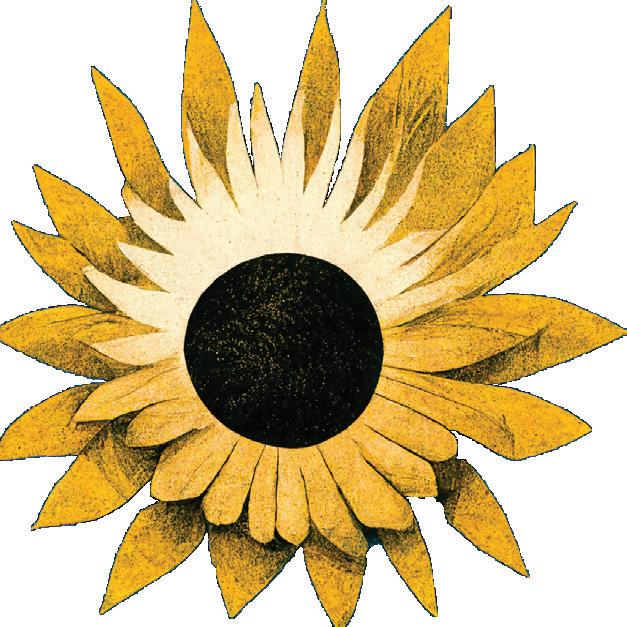

Many, including members of the MRU community, have gone above and beyond to assist Ukrainians in settling in Canada while the conflict continues.
Russia’s president Vladimir Putin began his invasion based on misinformation, but Ukraine is proving good communication can be an effective weapon.
Alumna Nataliia Klimenova spent last year worried about her family caught in the crossfire in Ukraine, but still managed to help lead the Cougars’ women’s volleyball team to a historic season.
Alumnus Jonathan Stewart was teaching English in Kharkiv when Russia attacked, forcing him to make a daring getaway as the violence escalated.
Canada has been working hard to bring Ukrainians here as quickly as possible, putting forth extreme effort within imperfect systems.
hard on the heart and mind
Celebrate the accomplishments of this year’s Alumni Achievement Award recipients: a police officer who involves the community in crime prevention, a residential school survivor helping others to heal, an iconic Calgary broadcaster who uses his voice for humanitarianism and the owner of a clothing company that doubles as a charitable organization.
Canadians are struggling with rising costs due to a perfect storm of economic influences, but are finding ways to persevere.
Mount Royal's current campus officially opened in 1972 and was a modern mega-structure with an art gallery, billiards hall, fireside lounge, dairy bar, pancake house, pizza place and the beloved Soup Kettle Inn.
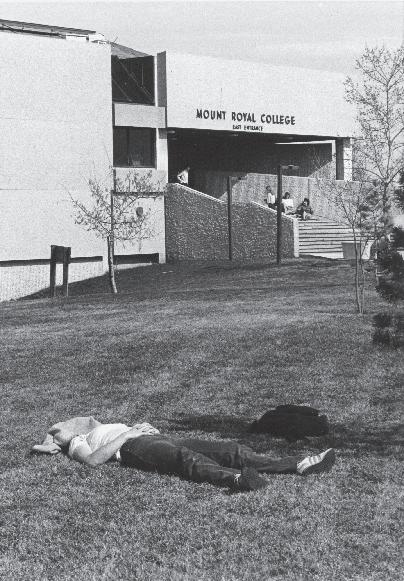


Jann Arden
Honorary Doctor of Laws, 2022
Jason Arthur Aviation Diploma, 2003
Launa Austin Bachelor of Communication — Information Design, 2022
Taylor Behn-Tsakoza
Bachelor of Health and Physical Education— Physical Literacy, 2021
Nicole Bell Bachelor of Nursing, 2022
Eric Bennett Bachelor of Applied Financial Services — Financial Services, 2007
Olivia Brodowski
Bachelor of Arts — English, 2022
Sean Crump Mathematics and general science
Pabandeep Dhaliwal
Criminology Diploma — Law Enforcement, 2001
Doug Dirks
Sports Administration Diploma, 1983
Jonah Hakkola
Bachelor of Nursing, 2022
Jo Horwood
Bachelor of Communication — Broadcast Media Studies, 2021
Dina Ibrahim Bachelor of Arts — Psychology, 2022
Skylar Kay Bachelor of Arts — English, 2019
Nataliia Klimenova
Bachelor of Health and Physical Education — Sport and Recreation Management, 2022
Phoebe Koenig Social Work Diploma, 2022
Kanakii Mekaisto Social Work Diploma, 2000
Dustin Paisley
Bachelor of Business Administration — General Management, 2015
Juan Pablo Quiñonez
Bachelor of Applied Health and Physical Education — Ecotourism and Outdoor Leadership, 2015
Harnarayan Singh Honorary Doctor of Laws, 2022
Elder Grandmother Doreen Spence Honorary Doctor of Laws, 2022
Kaitlyn Squires
Bachelor of Science — General Science, 2021
Jonathan D. Stewart
Bachelor of Applied Communications — Journalism, 2010
Don Taylor Honorary Doctor of Laws, 2022
Cathy Williams Honorary Doctor of Laws, 2022
Kathryn Zemp
Bachelor of Education — Elementary, 2022
Summit is published in the fall and spring of each year. With a circulation of approximately 64,000, each issue features the excep tional alumni, students, faculty and supporters who make up the Mount Royal community. Summit tells the University’s ongoing story of the provision of an outstanding undergraduate education through personalized learning opportunities, a commitment to quality teaching, a focus on practical outcomes and a true dedication to communities. Celebrate yourself through Summit.
ISSN 1929-8757 Summit Publica tions Mail Agreement #40064310 Return undeliverables to: Mount Royal University

Mount Royal Gate SW Calgary, AB, Canada T3E 6K6 Enjoy Summit online by visiting mru.ca/Summit.
If you would like a print copy deliv ered to your home or office, simply email summit@mtroyal.ca.
Mount Royal University is located in the traditional territories of the Niitsitapi (Blackfoot) and the people of the Treaty 7 region in southern Alberta, which includes the Siksika, the Piikani, the Kainai, the Tsuut’ina and the Îyâhe Nakoda. The city of Calgary is also home to the Métis Nation.
Sustainably yours.
Summit’s regular Bleed Blue section has been renamed Scratch Pad as a nostalgic nod to the campus’ student publication that ran in mimeographed format from 1942 to 1947. The year of Scratch Pad’s debut was also Dr. John H. Garden’s first year as principal of the then-Mount Royal College, and after whom MRU’s memorial garden is named.
THE SHELL GAMETiny shells discovered by a Mount Royal University researcher in 505-millionyear-old rocks have yielded new clues to peculiar animals known as stenothecoids, which have puzzled paleontologists for more than a century.
Dr. Paul Johnston, PhD, an associate professor in the Department of Earth and Environmental Sciences, made the find in Canada’s famous Burgess Shale on Mount Stephen in Yoho National Park near Field, B.C. Johnston’s discovery is an important piece of the Burgess Shale puzzle that illuminates how life evolved on Earth.

Previous researchers focused on splitting shale to expose well preserved but flattened specimens. Johnston examined nearby limestone layers and found three-dimensional shells of the mysterious stenothecoids. The problem was how to extract the delicate
centimetre-sized shells from the hard, encasing limestone.
“I could see with my hand lens that the stenothecoid shells had been replaced by silica during their half-billion year entombment, and so I could dissolve the limestone with acid in the lab to extract the shells,” Johnston said. “The results were excellent.”
Stenothecoids have an odd combination of shell features that don’t match any of the major groups (or phyla) of modern shelled animals. Like clams, the stenothecoid shell comes in two parts, known as valves. However, unlike the equally convex valves of early clams, the valves of stenothecoid shells are asymmetrical. This means they don’t match the other major group of duovalve shelled animals in Cambrian seas, the phylum Brachiopoda, which invariably show symmetrical valves.
This led most researchers to conclude that stenothecoids must represent an extinct group of the phylum Mollusca. However, Johnston’s find shows that stenothecoids possessed a previously undetected small opening at the apex of the shell like that in the phylum Brachiopoda.

With that realization, Johnston teamed up with brachiopod expert Michael Streng at Uppsala University in Sweden. They proposed that stenothecoids were an early evolutionary off-shoot from tubular Cambrian animals known as eccentrothecimorphs that ultimately gave rise to brachiopods that survive in modern oceans.
Their work has been funded and published, and the newly described Burgess Shale fossils will reside in collections at the Royal Tyrrell Museum and the Royal Ontario Museum.
This is how the fossils appear when exposed on the limestone surface.

Thousands gathered over three days in June for Mount Royal’s Spring Convocation ceremonies in celebration of education, camaraderie, community and achievement. A total graduating class of 2,217 are now members of the MRU Alumni Association.
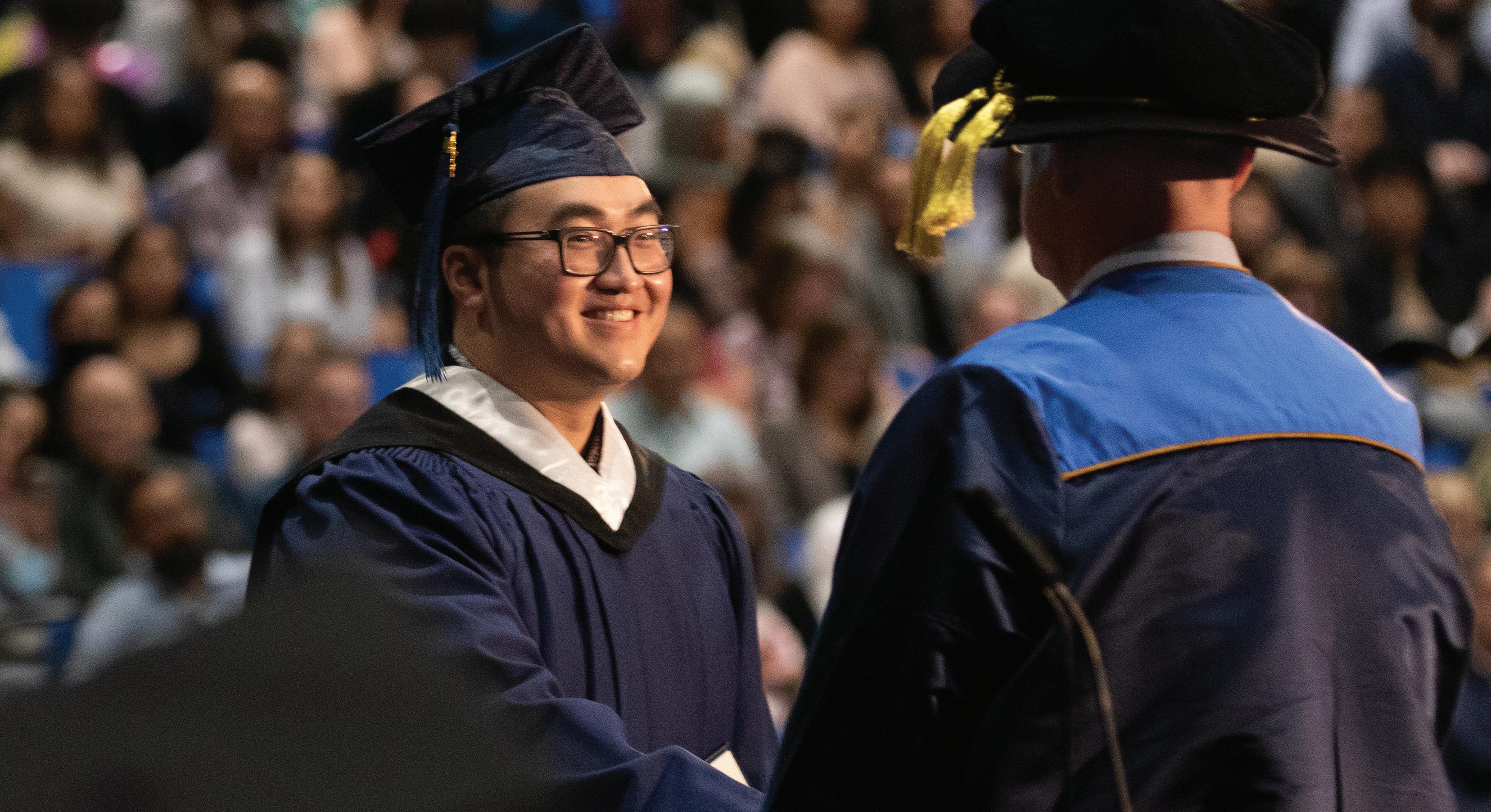

During his address at each ceremony, MRU President and ViceChancellor Tim Rahilly, PhD, took a moment to acknowledge and express thanks for the support students had along their academic journey from their family, friends and faculty members.
education
Rahilly said.
June 4 was a special day on Mount Royal’s campus as hundreds gathered for the annual Indigenous Graduation Celebration. As Mount Royal’s Indigenous student population has grown, so too has the event. Approximately 325 people attended, which honoured this year’s 80 Indigenous graduates of degree, diploma and certificate programs and the 25 graduates of the Indigenous University Bridging Program. A beautiful, painted 7.6 metre (25 foot) tipi from Ellery Starlight of Tsuut'ina Nation was added to the occasion and a number of elders and dignitaries attended in addition to proud family and friends.
After the grand entry, Espoom taah (helper) Roy Bear Chief of Siksika Nation opened with prayers and words along with Elder Louise Crane of Métis Nation Region 3 and Elder Hayden Melting Tallow of Siksika Nation. President of the Métis Nation Local 87 Joseph Pimlott delivered encouraging remarks to
graduates. Elder Melting Tallow gifted First Nations and Inuit students with an eagle feather while Métis students were given a sash by Elder Crane. The ceremony honoured Indigenous culture and tradition while also recognizing the elements of Western education the students earned.
Afterwards, celebrations continued with a meal, traditional powwow dancers Wandering Spirit, the Sorrel Rider Singers who drummed and sang, and Métis Nation 3 Dancers.
“You are now ready to go out and use your
to make a difference and contribute the unique value that only you have to offer this world,”WALKING IN TWO WORLDS

“Cheer other people on. Because they succeed, it does not mean that you failed. The whole idea of success being a ladder has always been the most absurd image that I could have possibly ever imagined. Success is not a ladder because it indicates room for one person going up and one person going down. Success is a horizon, it’s standing shoulder to shoulder with people.”
“There’s an unpredictability to life, but I would say to keep at it and whatever your hopes are, don’t let anybody try to get in the way of those and don’t let anybody discourage you. Through all those challenges and obstacles, try not to let them bog you down.”
“Life is a gift, not a given. Being intentional in your life is critical, so do everything with love and kindness — kisewatisiwin. Live your life to the fullest, be ready and listen to the messages that help guide your spirit. Know that you have the agency and responsibility to create positive change.”
“You are on the doorstep of a new stage in your life. One that is very exciting, and will also be challenging. But I’m sure you will all greet it with energy and a positive outlook. You will meet challenges if you accept opportunities.”
“Realize that life and careers rarely go in a straight line. Make changes when things don’t go according to plan ... It is critical to understand yourself, your strengths and your weaknesses. A strength taken too far can become a weakness, but you can manage a weakness when you understand it.”
Canadian Music Hall of Famer Jann Arden took theatre arts classes at Mount Royal College in the ‘80s, returning four decades later to receive an Honorary Doctor of Laws. In the interim, she has released 14 albums with 19 top-ten singles, won eight JUNO Awards, authored five books, starred in her own award-winning television show and was invested as a member of the Order of Canada. In her transparently pure and personal style, Arden spoke to the students with genuineness, humour and compassion.



An alumnus of MRU’s broadcasting program, Harnarayan Singh broke into Canada’s sports broadcasting landscape as cofounder and host of the Punjabi edition of Hockey Night in Canada. With talent recognized, Singh then became the first South Asian, Sikh or Punjabi person to provide playby-play (in English) for a televised NHL game. 2022 was also Singh’s NHL playoff debut as a commentator. His best-selling memoir, One Game at a Time, brims with humanity and explores what it is to be Canadian.

Elder Grandmother Doreen Spence became one of the first Indigenous licensed nurses in Canada in the late-1950s before moving on to be president of the Plains Indian Cultural Survival School in Calgary. She represented Canada as a member of the Working Group on Indigenous Populations to the U.N., founded and ran the Canadian Indigenous Women’s Resource Institute, served as an Elder for the U.N., and was nominated for the Nobel Peace Prize for the 1,000 Peace Women Project in 2005.
Known for a keen business acumen and his exceptional contributions to education and health care, Calgary philanthropist Don Taylor and his wife Ruth are MRU’s most significant private benefactors. In 2010, the Taylor Family Foundation provided $21 million to help build the Taylor Centre for the Performing Arts. In 2021 they donated a further $15 million for a campus renovation. Taylor is also a member of the Alberta Business Hall of Fame and an Officer of the Order of Canada.
A long-serving member of Mount Royal’s Board of Governors, Cathy Williams was instrumental in elevating Mount Royal's status from that of a college to a full-fledged university in her role as chair. An advocate for women in leadership, Williams has continuously defied gender stereotypes, starting with being one of the first female traders at the Bank of Canada. Inducted to the WXN Hall of Fame, Williams has also twice been named to the Globe and Mail’s 100 Most Powerful Women in Canada list.
This award is given to eligible MRU students based on a nomination system. The students must be graduating from diploma and degree programs, have a cumulative GPA of 3.7 or higher and demonstrate leadership through involvement in campus and community activities.

Established in 1873, this medal for exceptional academic achievement in a Canadian educational institution is one of the most prestigious awards that can be earned by a student.
Graduating with a Bachelor of Arts — English (Honours), Olivia Brodowski was selected as the 2022 Centennial Gold Medal recipient for the Faculty of Arts with a cumulative GPA of 3.88. Brodowski served as vice-president of both the Outdoor Adventure Club and the Film and English Student’s Society.
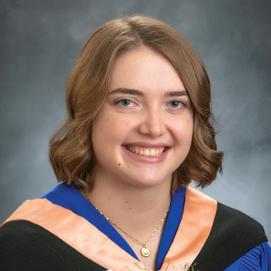
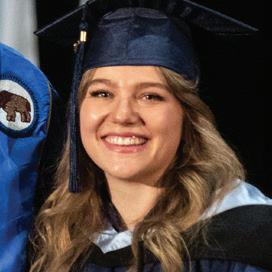



Nicole Bell graduated with a Bachelor of Nursing and was selected as the Centennial Gold Medal recipient for the Faculty of Health, Community and Education with a cumulative GPA of 3.97. Currently working in intensive palliative care, Bell plans on pursuing her master’s.
Kathryn Zemp was awarded the Governor General’s Silver Medal for achieving the highest academic standing of all graduates in a degree program at Mount Royal. Zemp left MRU with a Bachelor of Education — Elementary and a cumulative GPA of 4.0.
Phoebe Koenig was awarded the Governor General’s Bronze Medal for achieving the highest academic standing of all graduates in a diploma program. Koenig graduated with a Social Work Diploma and a cumulative GPA of 4.0.
A number of funding announcements occurred at MRU this year as the Government of Alberta seeks to increase opportunities in high-demand programs. In May, as a key part of the Alberta at Work initiative, $7.9 million to bolster the number of available seats in programs such as the Bachelor of Science — Computer Science, the Bachelor of Computer Information Systems and the Bachelor of Business Administration was provided to MRU. Five other institutions were also beneficiaries of a total $171 million investment.
Then in early October, a Memorandum of Understanding between the Government of Alberta and WestJet Airlines was signed promising $8.16 million in provincial funding for the growth of MRU’s Aviation Diploma, allowing MRU to add an additional 40 seats to help meet the known labour market demand for pilots. The government will also expand bursary and student loan programs for in-demand aviation occupations, including pilots and aviation maintenance personnel.
Advanced education is also spending $3.5 million to begin expanding opportunities for internationally educated nurses through programs such as MRU’s Bridge to Canadian Nursing. New bridging programs and a bursary to assist with the cost of becoming a nurse in Alberta will also be developed.
IN-DEMAND PROGRAMS RECEIVE FUNDING BOOSTAs a role model for women aspiring to science, technology, engineering and math (STEM) education and careers, Dr. Pamini Thangarajah, PhD, professor of mathematics at MRU, has been named to a prestigious group of university educators in Canada. She joins a reputable collective of scholars as a member of the Council of 3M National Teaching Fellows, an award that has been likened to the Stanley Cup of university teaching. Thangarajah is one of 10 postsecondary educators from across Canada to receive the honour this year. Thangarajah’s efforts, combined with extensive engagement in STEM outreach, serve to maximize student learning and development in inclusive and inspiring educational environments. Saying she had to overcome many obstacles to achieve her success, having been one of few women students throughout her educational journey, Thangarajah continuously works to change that for others.

In addition to MRU’s inaugural Environmental, Social and Governance Reporting (ESG) micro-credential, the Faculty of Continuing Education is now providing two more options for learners. mru.ca/ESG
• Applied Machine Learning (AML) Extension Certificate courses provide the necessary knowledge and hands-on skills to support data-driven business organizations and to leverage artificial intelligence technologies. mru.ca/AML
• Created with the office of indigenization and decolonization, Tipi Teachings are a series of immersive day-long courses taught by Blackfoot and Cree Elders exposing participants to a variety of topics. mru.ca/TipiTeachings
A recent funding boost from the province has also allowed for the development of three more microcredentials, currently in the works:
• Supply Chain Resilience and Scope 3 Reporting will broadly define concepts of supply chain resilience, lifecycle analysis and circular economy, and ladders on the existing ESG extension certificate.
•
Hormonal Contraception will allow registered midwife learners in Alberta to practice the skills necessary to prescribe, order and administer hormonal contraception.
• Bridge to Early Learning and Child Care (ELCC) links to discipline-specific topics. Completed micro-credentials and practicum hours can be applied to ELCC certification and may ladder into other programs.
Your Giving Day gift has an immediate impact on MRU students — scholarship support, mental-health programming, and so much more. Giving on Nov. 29 helps a student in and out of the classroom.
Being a Mount Royal alum comes with some pretty sweet benefits. The best way to have your cake and eat it too is to update your contact info with us.

mru.ca/Always
Mount Royal alumni can enjoy a whole world of benefits including:
• discounted Recreation memberships
• discounts on mobile devices and phone plans
• access to Career Services for new grads
• discounts on concert tickets
• preferred insurance rates
Become a mentor, volunteer at Open House or Convocation or attend an event. There are so many ways to give your time to Mount Royal.
Sign up for the alumni e-newsletter at mru.ca/Always to stay in the loop.
Every student can use a helping hand on their journey. Consider contributing to an alumni scholarship or bursary.
Visit mru.ca/Giving for more info.
Connect with us on Instagram, LinkedIn, Twitter and Facebook.
@mrualumni alumni@mtroyal.ca 403.440.7000
Now ten years old, the JMH LaunchPad Pitch Competition is hosted by MRU’s Institute for Innovation and Entrepreneurship. Finalists from many Mount Royal programs pitched their business concept to a panel of experienced judges in a Dragons’ Denstyle match-up, vying for a share of $70,000 in prizes. This year’s donor community consisted of the RBC Foundation, LaunchPad alumni, connectFirst Credit Union, Grant Design and, of course, JMH & Co.
LAUNA AUSTIN
$10,000 JMH & Co.
$5,000 LaunchPad Alumni Award
A recent information design graduate and the founder of Husky Jocks, Austin creates athletic clothing for children of all shapes and sizes.
ERIN CREEGANDOUGHERTY
$10,000 JMH & Co. Creegan-Dougherty is a business student and the backbone of Maskwa Backcountry Foods, which makes camping meals using traditional Indigenous recipes.

DALE SWAMPY
$10,000 connectFirst $15,000 Grant Design A computer information systems student and the founder of Osaw Kihew, Swampy sells unique, Indigenous-made star blankets deeply rooted in history.


DINA IBRAHIM

$10,000 JMH & Co. A psychology alumna and the founder of HYAT CO., Ibrahim has built an inclusive brand providing beautiful, innovative and affordable hijabs for women of all types.

A $500,000 donation from TD Bank Group (TD) to Mount Royal’s Institute for Innovation and Entrepreneurship, combined with federal and provincial funding of $1.4 million each, provided for the province-wide expansion of the Institute’s Growth Catalyst program plus additional initiatives. This increase in business growth offerings is set to trigger the creation of hundreds of new jobs and deliver millions in economic impact to Alberta over the next few years.
Growth Catalyst is a scale-up program targeting established Alberta businesses with ambitions to become world leading. Extensive research on the drivers of small- and mediumsized business growth carried out by Dr. Simon Raby, PhD, associate professor of innovation and entrepreneurship and academic director of Growth Catalyst, uncovered seven strategy components that business leaders can deploy to

CRYSTAL WAI
$10,000 JMH & Co. The founder of Memoir Candles is also a science student whose business incorporates memorytriggering scents like spa day, breakfast cereal, ice wine and more into homemade candles.
catalyze, and more readily sustain, new episodes of growth.
Raby said, “TD, and the provincial and federal governments, have recognized the inherent value within the business owners and leaders across the province and that we can really support their organizations to grow and develop. A focus on established innovation-driven enterprises and how we help them unlock their growth capacity and capability is key.”
The Institute’s business growth initiatives also include the Innovation Accelerator program, which trains teams on a repeatable and scalable innovation process to capture new value and revenue streams. The Growth and Resiliency Speaker Series is geared towards sharing the latest best practices on company growth and scaling up.
Participants are supported by students from MRU and other institutions, with partnerships often leading to employment opportunities.
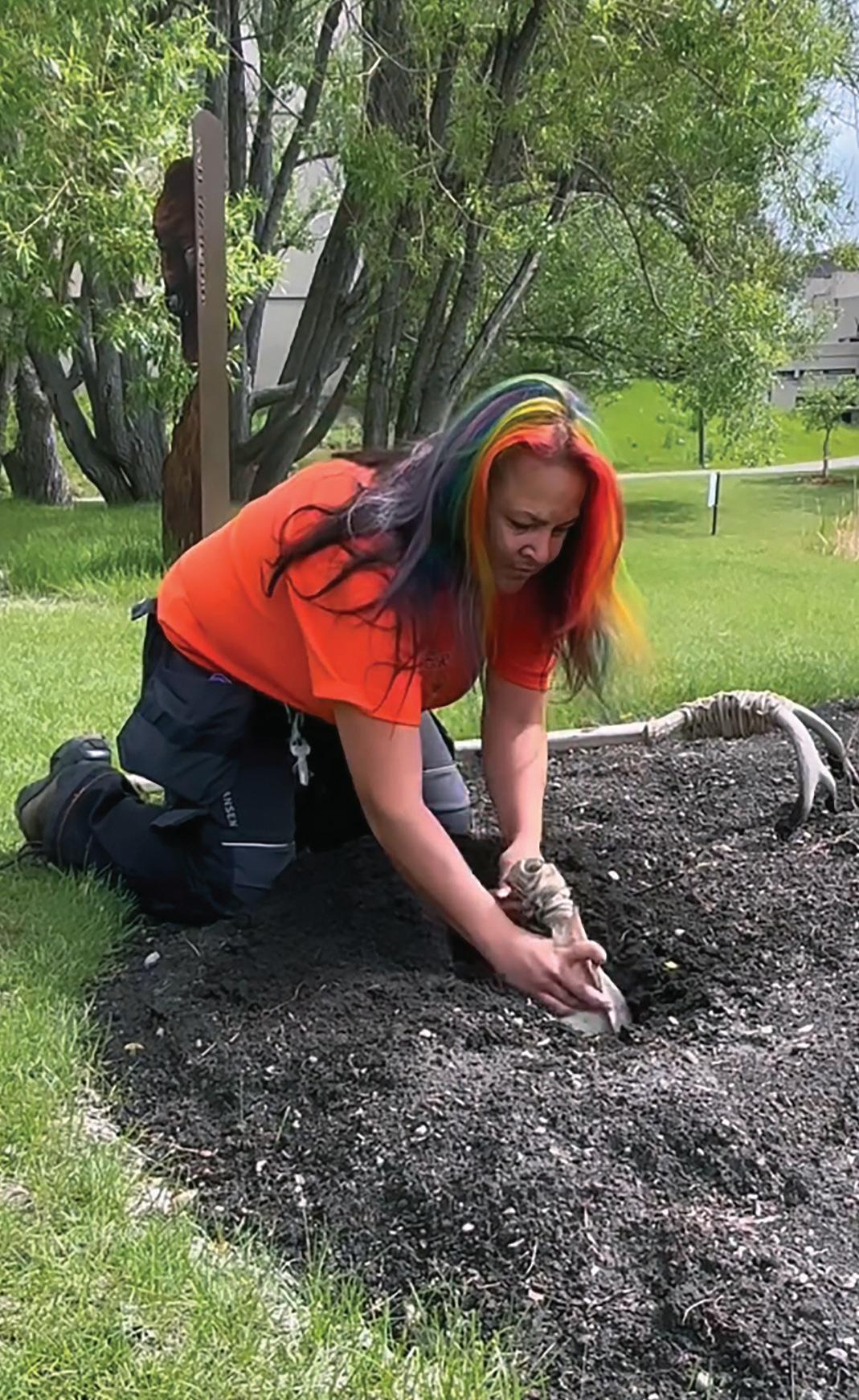

Pre-contact seeds, planted in the spring of 2022, grew on Mount Royal University’s campus all summer, celebrating and honouring Indigenous culture and traditions. There will soon be four Indigenous gardens on campus representing the four directions of the medicine wheel.

dr. linda manyguns, phd, associate vicepresident of the office of indigenization and decolonization, provided the seeds, which are from the time before contact between Indigeous Peoples and outside cultures. They came from Buffalo Bird Woman, one of the last Indigenous
gardeners who shared knowledge of the traditional Hidatsa agricultural practices. Tobacco and sweetgrass were planted, with the tobacco harvested to be used as traditional offerings to Elders, a practice of the Blackfoot people. Elsewhere on campus the Three Sisters flourished: corn, beans and squash. The three different veggies work synchronously, with the corn providing sturdy support for the beans, which in turn coil up the stalks to keep the corn stabilized. The leaves from the ground-dwelling squash keep the soil moist and cool.
Not only were the gardens planted using pre-contact seeds, they were
tended to using traditional Indigenous tools and practices.
One of those practices, says Carmela Amoroso, irrigation specialist with MRU Grounds, includes singing to them.
Amoroso, who is Assiniboine and whose mother is a residential school survivor, says, “We brought the tobacco out to plant and linda (dr. manyguns) explained that we have a responsibility to the plants and animals around us and part of that is bringing them into their new home with a song. The traditional way was planting and singing and it would bring the plant into its new place, providing oxygen.”
FROM SEED TO HARVEST Carmela Amoroso, irrigation specialist with MRU Grounds, uses a rake made with antlers to prepare the ground for seeding. linda manyguns, phd, associate vice-president of indigenization and decolonization, provided pre-contact seeds for the Indigenous gardens.
Ecotourism and outdoor leadership Juan Pablo won season nine of the History Channel’s , where contestants are dropped off in a remote, undisclosed location with only 10 survival tools at their disposal. Quiñonez, the first Latino winner, lasted 78 days and took home $500,000, with which he plans to buy land and start a co-operative community.
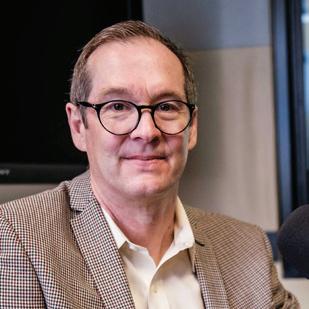
Dr. Brad Clark, PhD, associate professor of broadcast media studies, released a new book, Journalism’s Racial Reckoning: The News Media’s Pivot to Diversity and Inclusion, this year. The work is intended as a resource for students and scholars of journalism, journalism ethics, sociology, cultural studies, organizational studies, media and communication studies.
Professor of geography Dr. Lynn Moorman, PhD, was chosen as the recipient of this year's Award for Excellence in Teaching Geography by the the Canadian Association of Geographers. Moorman teaches physical geography, geomorphology and advanced GIS/spatial analysis.
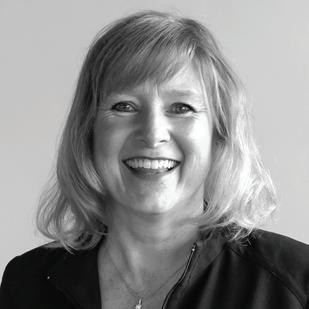

Bachelor of Science — General Science alumna Kaitlyn Squires was one of four Canadian Map the System finalists selected to travel to the University of Oxford to compete in the global final in June. Squires represented Mount Royal with her study titled “Sex Workers in Canada Face Unequal Access to Healthcare.”

Acting as a youth delegate for the Assembly of First Nations, last spring Taylor BehnTsakoza (Dene, Fort Nelson) travelled to the Vatican to represent Indigenous intergenerational survivors. Behn-Tsakoza, the daughter of residential school survivors, graduated in 2021 with a Bachelor of Health and Physical Education — Physical Literacy.

Heather McLellan, associate professor, Advanced Studies in Critical Care Nursing — Emergency (ASTNA), was inducted as an inaugural fellow of the Academy of Air and Surface Transport Nurses at the Critical Care Transport Medicine Conference. Those who are named ASTNA fellows are committed to contributing continued leadership and service to the critical care transport community.

Recent Bachelor of Nursing graduate Jonah Hakkola was one of 40 recipients of the 2021/2022 Persons Case Scholarship, a program of Alberta’s Ministry of Culture and Status of Women.

Hakkola intends to further develop his skills as a leader, researcher and advocate within the nursing field.
Bachelor of Arts — English alumna Skylar Kay ’s collection of autobiographical haibun, a style of Japanese poetry combining haiku and prose titled Transcribing Moonlight, outlines a year of her life as a trans woman. Kay has pursued Japanese influences in her poetry since 2016 and also participates in the academic side of Japanese literature.

Dr. Leslie Robertson, PhD, of the Department of Education, received a 2022 Calgary Black Achievement Award (CBAA) for making a positive impact in the education field. The CBAA Hall of Fame recognizes Black people in the Calgary area who have exhibited an impressive history of high achievement, success and excellence.
TD Insurance is proud to support the Mount Royal Alumni Association and the 2022 Alumni Achievement Awards. Watch the recipients’ videos at mru.ca/AAA.

Social Work Diploma, 2000
Using dance and wrestling as his tools, Dhaliwal teaches at-risk youth about the importance of caring for others and empowers them with the skills and knowledge needed to make good decisions.
Walking in two worlds, Mekaisto blends formal education with ancestral teachings, ceremony and storytelling to help others overcome their trauma and find their identity.

For the last three decades, Dirks’ voice has connected Canadians at home and around the world as an anchor, host, commentator and reporter with CBC. He has also helped raise millions for local charities.
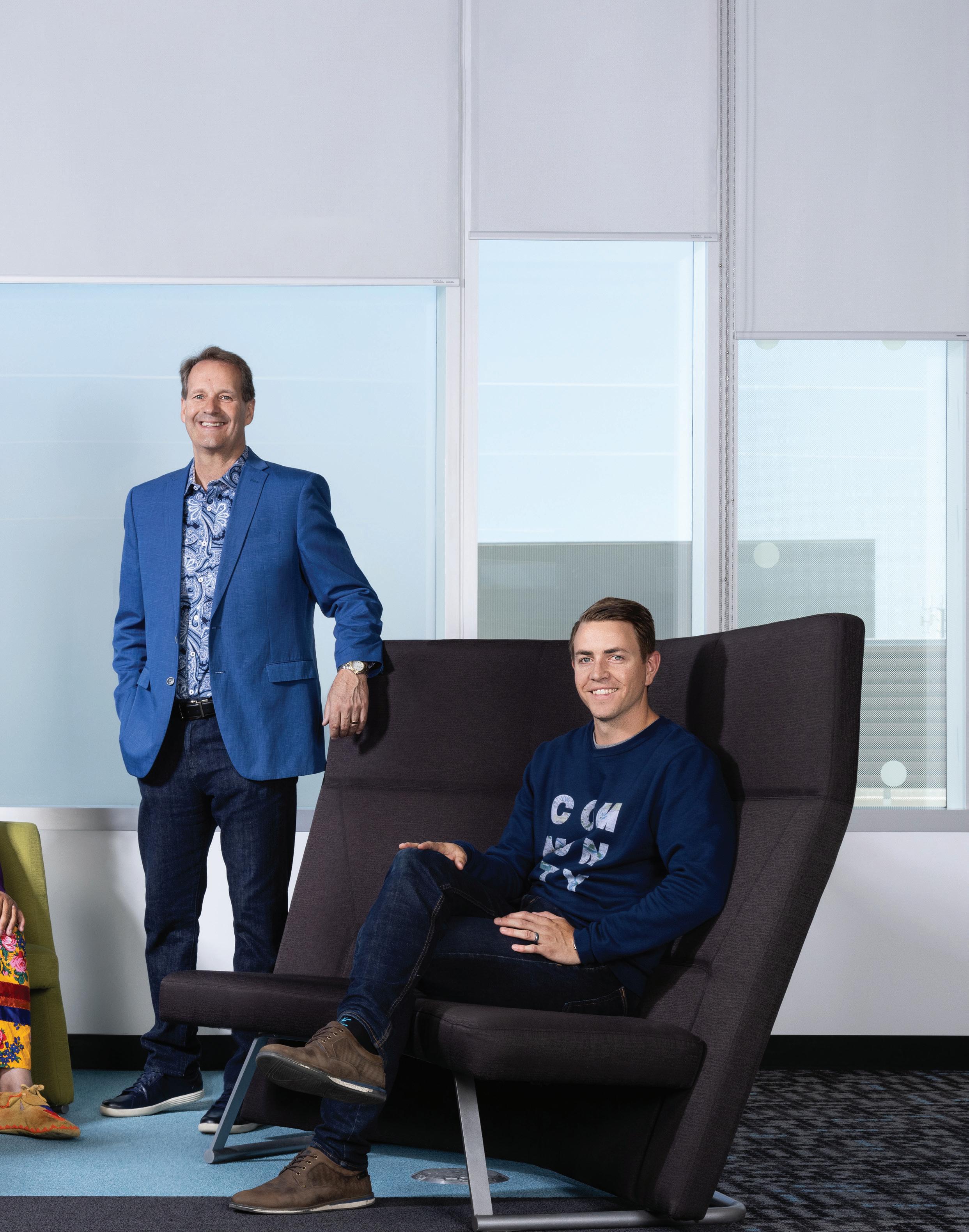
As a social entrepreneur and co-founder of Local Laundry, Paisley is standing up to fast fashion and pledging $1 million to charity by 2030.
Research taking place at MRU is contributing to the growing body of knowledge needed to improve community wellness, shape policy and forecast a positive future.
Department of Entrepreneurship, Marketing and Social Innovation

Bringing together her background as a graphic designer and brand strategist, Dorland uses qualitative research to develop enhanced creative capacities in organizations, classrooms and communities. As associate director of MRU’s Institute for Community Prosperity’s CityXLab, Dorland and student researchers delve into the changing nature of Canada’s creative and cultural future to better understand how creative thinking practices can help institutions of all types thrive. Her research into the energy industry proposed a conceptualization of the problem-solving work leadership carries out, and provides evidence for the use of creative workplace tools such as storytelling, intra-organizational team discussions and ways to look for solutions in different contexts.
“My research is focused on finding out how we might amplify creativity and creative thinking skills to help create meaningful and innovative change,” Dorland says.

Dorland received a Social Sciences and Humanities Research Council grant in 2022 for her study on “creative futures” and also regularly contributes to several international publications.
Associate Professor Emily Hutchison, PhD Department of Humanities



Hutchison examines the complex and changing relationship between ruling political elites and the broader populace in late-medieval France, especially during a period of violent civil war. In her studies she has revealed how the lower classes, or the Third Estate, used spaces in the city to give voice to their struggles. Late-medieval Parisians were able to generate substantial political agency through calculated spatial maneuvers, which enabled them to communicate their political desires effectively.

“The studies that I have undertaken can teach us a lot about how people move and operate in a city underneath the radar and how people seek to contest the attempts to limit and control them,” Hutchison says. “I am writing the history of Paris by examining the interaction between gender, space and agency.”
In 2021, Hutchison was awarded a Social Sciences and Humanities Research Council grant to fund her study, “A View from the Street: The Genderscapes of Late Medieval Paris.”
Professor Mohamed El-Hussein School of Nursing and Midwifery
More than 131,000 Canadians each year suffer a fragility fracture after a slip, trip or fall from standing height. Having someone at home to care for them when they leave the hospital is critical to their recovery, but how can society support caregivers? Investigating an issue like this through a nursing lens is what drives El-Hussein.
In his current two-year study, El-Hussein and co-researchers will interview 60 caregivers of patients with fragility fractures, centring questions on the role of the family in determining who becomes the primary caregiver, how they prepare for the patient being discharged and their daily experiences in caring for the individual, including taking them to appointments.



“The driver for my research is my students and my patients in order to better the outcomes for both,” ElHussein says, who is co-investigator on a Canadian Institutes of Health Research grant for his work.

Professor Aliyah Dosani, PhD School of Nursing and Midwifery
Dosani’s research involves giving women living in rural Rajasthan, a state in northwest India, a camera and asking them to take pictures of how they understand depression in their cultural context. These women come from resource-poor communities with little-tono mental-health support. In tandem, lay counsellors who deliver basic talk therapy take field notes about what they are seeing during counselling sessions. The research team then analyzes the photos and case notes to better understand how the women are experiencing depression.
“For me, it’s all about health equity and social justice. What do we do about the obvious disparities we see in health — differences that are systematic, avoidable and unfair?” Dosani asks.

Dosani received a Canadian Institutes of Health Research grant for her work, “Using Photovoice and Critical Social Theory to Help Develop Culturally Safe Services for Perinatal Depression in Rural India.” She is principal investigator, leading the work alongside colleagues from other institutions.
Assistant Professor Margaret Stewart, PhD Department of Earth and Environmental Sciences
Using geological field mapping, remote predictive seafloor mapping and microanalytical techniques, Stewart studies the relationship between plate tectonics, crustal-scale structures and magmatic-hydrothermal mineralizing systems in modern and ancient arc and back-arc settings. Her research is focused on the Lau Basin of the southwestern Pacific Ocean and the Stikine Terrane of northwest British Columbia, which formed as an independent, intraoceanic volcanic arc during the Paleozoic and Mesozoic eras.
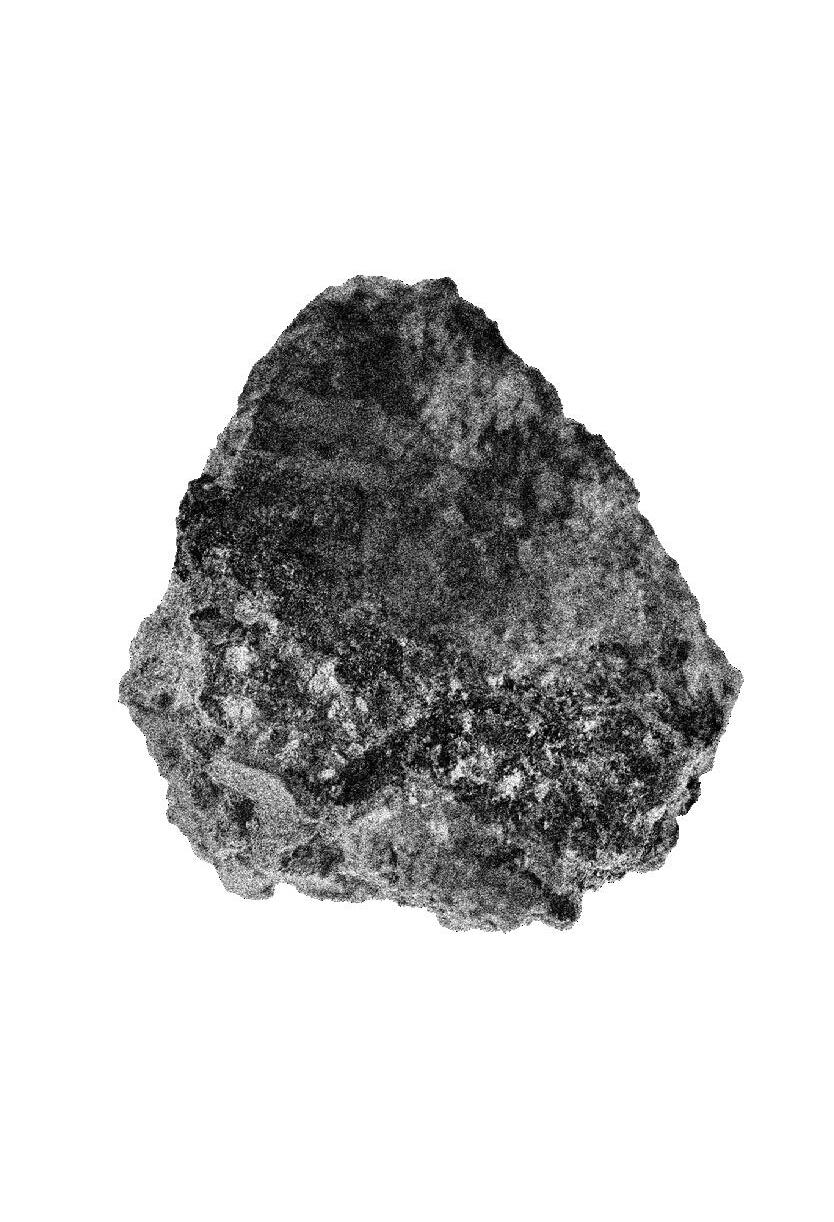
Long-term objectives are to improve genetic models of magmatichydrothermal mineralizing systems by determining how tectonic controls on these ore systems have evolved.
“As low-carbon energy sources replace non-renewable resources, there is a growing demand for critical metals,” Stewart says. Meeting this demand requires an innovative approach to studying ore systems that integrates an understanding of the controls on mineralization at a variety of scales.
Canadians are struggling with rising costs due to a perfect storm of economic influences.
Canadians are well aware of the increased cost of living as each trip to the grocery store tallies higher and higher despite fewer items in the cart.
That feeling is also familiar at the gas pump as the price to fill up reached record highs across the country early in the summer. On top of that, add increased insurance rates, price hikes for coffee and extra charges at the movie theatre. The fact that wage growth is not keeping up with the rate of inflation has left many to watch their cheques being stretched thin from payday to payday, causing stress and provoking lifestyle changes.
Simply put, says Dr. Anupam Das, PhD, an economics professor at MRU, inflation is the increase in price for goods and services over a period of time. Generally measured year over year, Canada’s inflation rate hit 8.1 per cent in June, the highest it’s been in nearly four decades. That means that the cost for goods and services (things like housing, food, transportation and entertainment) was 8.1 per cent higher than just 12 months ago.
The last time inflation rose that much annually was in 1983, when Star Wars: Return of the Jedi was playing in cinemas, “Every Breath You Take” by The Police and Michael Jackson’s “Billie
Jean” were two of the top songs playing on the radio, and the world met Mario in the first-ever Mario Brothers Nintendo game.
A maximum two per cent inflation rate is the target set by the Bank of Canada (BoC). The target rate was established in 1991 after inflation reached record highs in the late 1970s and early 1980s, hitting 12 per cent in 1981.
Inflation has been above the two per cent target for more than a year. But although things were bad 40 years ago, they are even worse now. According to the BoC’s inflation calculator, a basket of consumer goods and services worth $100 in 1981 would cost the average person $303.38 today.
Prices for fresh fruits and vegetables as well as meat products are all up roughly 10 per cent compared to 2021. But, it’s not just produce wracking up your grocery bill. Canada’s Dairy Commission approved two milk price increases, a rare move that came less than halfway through the year. In its decision, the Commission cited inflation as the reason for the hikes, pointing out that even with two increases this year the price of dairy is only up just over seven per cent over five years as compared to eggs, fish and meat, which saw increases of 21, 32 and 14 per cent, respectively, over the same period.
According to economists, the cost of food and shelter are the primary drivers of rising inflation. Statistics Canada data (August) shows food prices are up 10.8 per cent year over year while costs for shelter are up more than 6.6 per cent.
While those numbers do paint a bleak picture, the real-time experience of Canadians is even more alarming as almost three in four say rising food prices are keeping them from meeting other day-today expenses.
Das explains that generally inflation happens for one of two reasons: an increase in demand or a decrease in supply. Canada’s current inflation rate can be blamed on both, he says.
“The demand side of inflation comes from the fact that as the economy started coming out of COVID-19, people are getting more and more jobs, companies are hiring more, people are now going out more. We see that demand is pushing prices up.
“Now, at the same time, for several reasons, there is supply side inflation too. Number one because there are some shortages of all sorts of things that COVID caused.”
Russia’s invasion of Ukraine is another reason prices are up around the world.
Das explains that globally, oil prices are a major determinant of the supply side of inflation and the conflict has caused a large supply gap as western countries introduced sanctions against Russia, including on its oil.
The country is responsible for 13 per cent of the world’s crude exports so, naturally, markets were thrown for a loop when the war began in February.
It’s not just crude oil prices that are affected. Ukraine exports almost half of the world’s sunflower seed oil, and Russia is second at 23 per cent. The invasion began in the first quarter of the year, but its impacts are being felt months later. In May, Statistics Canada recorded the largest increase ever (30 per cent) for cooking oils and edible fats.
For context, three litres of vegetable oil cost, on average, just over $6 in 2018. The same volume costs about $11 in 2022.
There are other contributors, too, such as natural disasters like the November 2021 floods in B.C., which caused widespread supply chain issues in Western Canada that had ripple effects across the country.
Although it’s not much consolation, Das points out that inflation is not just a Canadian problem, but one that is affecting other countries as well.
“Inflation hit seven per cent in the U.S. way before Canada. There is a global inflationary problem.”
Inflation can also be a matter of perception, Das says.
“Inflation is the change in price from one period to another. During COVID times our prices were actually quite low because we did not see a lot of economic activities. So, any change in price will be kind of amplified when you see the inflationary number.”
Das uses fuel as an example. In early 2020, gas was averaging between 80 and 90 cents per litre in Calgary. That price shot up to $1.91 per litre in the late spring.
“It started with a low price so any change in price will look big. Now, of course, the price change is big, I mean we have not paid $1.91 in recent history. But when we start with 80-cent gas, even the jump up to $1.20 looks big.”
Gasoline prices across Canada over the summer were up 54.6 per cent compared to 2021.

Wages have been rising, according to the Conference Board of Canada, although not by enough to match inflation. Das points out that data from the Conference Board (a non-profit, non-partisan think tank) shows hourly wages rose by 5.2 per cent between 2021 and 2022, while inflation hit 8.1 per cent.
“Perhaps companies are paying their employees more. But the important issue here is that employees are still worse off because the wage growth is not keeping up at the same pace with inflation,” he says.
This comes as the wage gap between the lowest and highest earners in the country continues to widen. While wages and salaries for lowerincome earners have been going up, their average disposable incomes are going down. Conversely, the first quarter of 2022 saw the disposable income of the top 20 per cent of earners go up (roughly two per cent, year over year).
That, coupled with the expiry of government pandemic support measures, Das says, is causing a further divide between the lowest and highest earners.
According to Statistics Canada, even though low-income earners have seen salary and wage gains, the ending of programs like the Canada Emergency Response Benefit have had “more significant repercussions.”
Das says that on top of this, racial and gender wage gaps still exist.
“Racial minorities and women have historically received fewer dollars than that of Caucasian Canadians who are men. It is possible that even when wages rise, marginalized people of society will not see the same wage growth.”
“Perhaps companies are paying their employees more.
But the important issue here is that employees are still worse off because the wage growth is not keeping up at the same pace with inflation.”
— Anupam Das, PhD professor of economics
To combat inflation, the BoC has increased its benchmark interest rate multiple times already this year. It is important to know the basics of how the borrowing system works in order to understand how this affects inflation.
Average people borrow money from commercial banks like BMO or RBC, and those banks borrow from the BoC. So, when the central bank raises interest rates, it costs the commercial banks more to borrow, increases that are passed on to consumers.
The BoC slashes or raises interest rates in an effort to regulate the economy (to a certain extent). When the economy is slow, interest rates are lowered to promote borrowing, investing and spending. Conversely, when inflation is high, rates are raised to slow the economy.
In early September, the BoC raised its overnight rate by 75 basis points to 3.25 per cent. Interest rates have been raised five times so far in 2022, with analysts predicting another hike to bring it to four per cent.
Commercial banks were quick to follow suit, raising their lending rates as well, with the cost to borrow ranging anywhere from three to five per cent.
Das believes that the hike will help, but it won’t bring things down to prepandemic levels.
“By increasing their own interest rate, the BoC is slowing down the economy. It’s not just consumers who borrow money from banks … farms and other businesses also borrow money from banks. So, businesses like farms will then have increased
operational costs and will slow down their activities. For consumers, it costs more to borrow money, so they too will slow their spending and this is how it trickles down from the BoC to the overall economy.”
And while all of this might mean cheaper groceries and gas eventually, there is a risk of some people getting caught in the crossfire, so to speak.
Bennett says anyone who is up for a mortgage renewal will likely face a much higher rate. And for those who aren’t homeowners yet, getting into the market might come with a hefty price tag that will only grow with the higher cost of borrowing.
In its most recent quarterly report, the National Bank of Canada’s Housing Affordability Monitor reports home prices in Calgary are on the rise. At an average cost of $542,901, a household needs to make at least $121,068 per year in order to afford a home and save for 39 months at a rate of 10 per cent for the down payment.
The condo market in Calgary is much more affordable, says the National Bank, which reports that
there is a long-term discount for those who buy a two-bedroom condo as opposed to renting. Those looking to buy need to make just over $56,000 a year and save for 17 months (again at a rate of 10 per cent) to afford the average condo, for which the mean price is $251,412.
These prices might be out of reach for many, especially when combined with high prices for energy and food and wages not keeping up with costs. However, Calgary is on the lower end of the scale as compared to other major Canadian cities in terms of mortgage payments as a percentage of income. Those living in a house in the city spend roughly 37 per cent of their income towards mortgage payments while condo owners spend about 17 per cent.
Alumnus Eric Bennett, a senior wealth advisor with ScotiaMcLeod/ Scotia Wealth Management and a member of MRU’s Alumni Council, stresses that this inflationary period will level off. In the meantime, however, how are people going to manage?
“The dreaded ‘b-word,’” Bennett says when asked what tips he has for those struggling financially.
“It’s one of those things that nobody likes to do or talk about. It’s a pain,” he says, pointing out that in his experience less than five per cent of clients have worked out solid budgets.
“During tough times like these, sit down, write out everything from your Netflix to your internet costs to your cell phone to your food to everything. And track that over maybe the last three months to get a good feel for what your true monthly burn rate is.”
Bennett says this is an efficient way to outline exactly where your money goes and what your costs are.
“It’s all the small things. I call it death by a thousand cuts. It’s just the small little leakage you have here and there with buying coffee and not paying attention to where all the expenses are going. Some people have multiple Netflix accounts and they don’t even know.”
Now is not the time to be “keeping up with the Joneses,” Bennett says, and instead people should focus on what costs can be cut temporarily while prices are so high.
Bennett suggests taking advantage of technology available to help budget, such as apps.
— Eric Bennett senior wealth advisor, ScotiaMcLeod/ Scotia Wealth ManagementA recent BoC survey shows how Canadians are adapting to higher prices. Many are postponing major purchases and cutting unnecessary spending, especially those in lower-income households. On top of that, more people are shopping for items that are on sale or buying more generic brands as opposed to name brands.
The survey also found that some are using cheaper forms of commuting, like cycling, to help limit gas spending.
There’s no doubt that Canadians are feeling the financial pinch. Things will get better eventually, but likely not as quickly as hoped. Inflation is already on its way down, but the decline is at a much more leisurely pace than the rise. In July, inflation was at 7.6 per cent, and by August it was at 7 per cent. It’s not much solace, but Canadians have weathered the inflation storm before and are finding ways to face what comes ahead.
“It’s all the small things. I call it death by a thousand cuts.”
The choice was made to illustrate these pages using artificial intelligence (AI), which we believe can stand as a metaphor for the Russo-Ukrainian War. Ukraine has fought back against Russian misinformation using advanced technology combined with skilled communication — elements that help create AI art. The designer must carefully input prompts to cause the technology to produce what they imagine, and the results are often unexpected. The prompts used to create each image for this section have been provided.
Alberta is home to more than 345,000 people with Ukrainian heritage, which is why Russia’s February invasion of the country has affected so many of the province’s people on a personal level. There are now more than 4,000 Ukrainian nationals in Alberta seeking safety while the war continues.
This section of Summit is dedicated to stories of Ukraine: how the war was fueled by propaganda, how family members living far away are coping, how an alumnus experienced the war first-hand and how Canada is working to help.
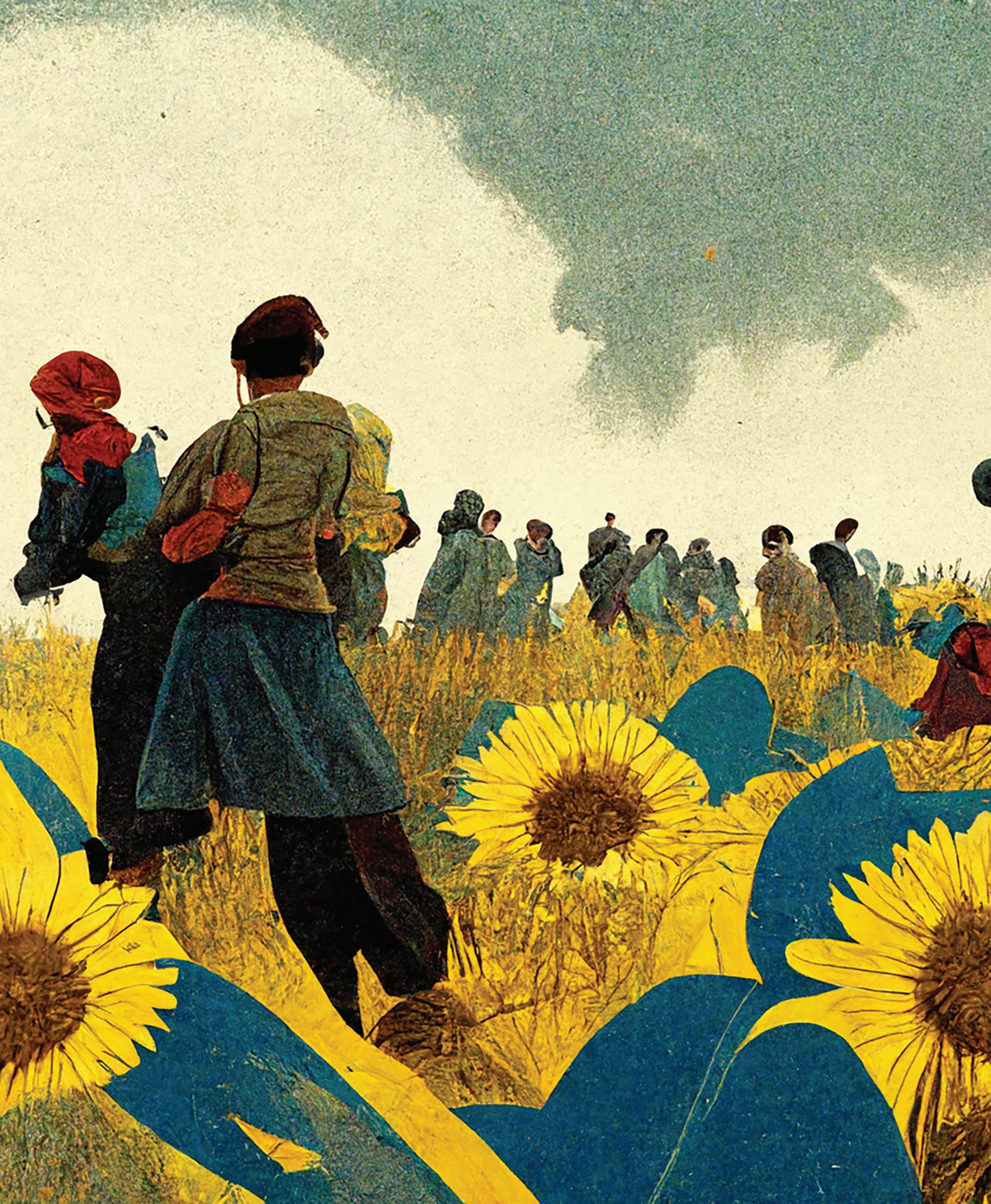
Ukrainians have been welcomed by the MRU community.
 Words by Michelle Bodnar
Words by Michelle Bodnar
The generosity and compassion of Canadians has been on display as tens of thousands have opened their doors to Ukrainians seeking refuge from the invading Russians in their country. The Mount Royal community has played a part as well. The University has been housing Ukrainians on campus in Residence since the summer.
One of the guests has been Oleksandr Mastiukh, a 3D artist with a master’s in international economics who came from Kharkiv, a large city close to Ukraine’s eastern border that has been targeted by the Russians since the beginning of the war. He said he was grateful to be at MRU.
“After two months of hearing bombing and shelling, it’s really relaxing to be here.”
Mount Royal aviation alumnus Jason Arthur, safety manager for MRU’s Aviation Diploma and an experienced helicopter pilot with STARS Air Ambulance, has also taken the opportunity to house a displaced Ukrainian. He spotted a post on the Facebook group CANADA — Host Ukrainians / Hébergeons les Ukrainiens where Vladyslav Vitske was looking for a Canadian host. Arthur responded.
It turned out that Vitske had been close to starting his aviation training in Ukraine when the war broke out. His flight school was destroyed.
“It just happened that he had similar dreams to follow the same career path and become a pilot. So, I definitely wanted to help him out and let him be able to achieve the dreams that everyone should be able to,” Arthur says.
Vitske, who had been taking refuge in various parts of Europe, applied for the proper visas and Arthur purchased him a flight to Canada. All in all, it took close to three months to bring Vitske to Calgary, where he has been staying with Arthur and his family. Vitske’s dad and brother are both fighting in the military, with his brother hospitalized twice because of rocket attacks. His mother, younger brother and grandparents remain in Kiev.
“It’s definitely a difficult time for him, because although he’s in Canada, a lot of what’s going on in his mind is still caught up in being in a war and where his family is.”
Arthur has taken Vitske on tours of the STARS and MRU hangars, treated him to a flight in an MRU aircraft, provided Vitske with study materials, and began a GoFundMe to help Vitske pay for his Canadian education. With the goal of living in Canada, Vitske must first work for 12 months to gain permanent residency status. He found a great position as a flight supporter with AirSprint Private Aviation and began flight training courses this fall.
“It’s a big commitment, but, you know, it worked out really well in our situation,” Arthur says. “People need to move beyond their comfort zone and maybe do a bit more than just what they think would be needed of them.”
The invasion of Ukraine sees an ongoing battle unfolding on the frontlines as a war of words is waged across a world where information can move as quickly as the click of a mouse.
In late February 2022, Russian troops moved into Ukraine in what is being sold by the Kremlin as “a special military operation,” but assessed by much of the West as an unprovoked invasion.
As the conflict continues, one thing is clear — propaganda masterminds working the narrative for the Russian side are delivering non-stop misinformation and disinformation in a bid to justify what has been dubbed (President Vladimir) Putin’s War.
Although there is much conflict on the ground, the war in Ukraine is also being fought over the internet, with words acting as an effective weapon for both sides.
Communication is a powerful weapon in the conflict, where wins and losses happen on the ground, but traction sees allies recruited online. Even before Russia’s attack, media platforms were greased with creative content stoking its support.
It’s old, Soviet-style propaganda meets newworld communication channels like Twitter and TikTok, says Dr. Kari Roberts, PhD, associate professor and chair of Mount Royal University’s Department of Economics, Justice and Policy Studies.
She says there was a time, not long ago, when “professional gatekeepers” ensured information
 Words by Nadia Moharib
Words by Nadia Moharib
(pro.pa.gan.da) n — the spreading of ideas, information, or rumor for the purpose of helping or injuring an institution, a cause, or a person: ideas, facts, or allegations spread deliberately to further one’s cause or to damage an opposing cause
— Merriam-Websterpeople received had the facts right compared with today when “Aunt Deb’s post on Facebook offers vaccine research.
“Everyone can have an opinion and everyone can have a wide audience,” she says.
And that can be dangerous.
“I think of propaganda as state-sponsored information,” says Dr. Brad Clark, DComm, an MRU broadcast media studies professor.
“It doesn’t necessarily contain elements that are factual or the truth and that doesn’t really matter. What matters are the aims of the state in forwarding its position that supports its goals and needs. Whether we are talking about casualty figures during the Vietnam War, news releases by the U.S. government or Russian campaigns to portray people in Ukraine and their leadership as Nazis … the goal is to present a point of view consistent with the aims and direction of the government, the people in power.”
Technology allows individuals and governments to control the discourse and narrative. The facts are optional.
“Now, you don’t, as a government, have to assemble reporters in a debriefing room at the White House or 10 Downing Street or on Parliament Hill in Ottawa. You can get messaging out through social media either officially or through people who support your aims,” Clark says.
Suggestions by Russians claiming they are “deNazifying” Ukraine are absurd as are accusations Ukrainian President Volodymyr Zelensky (who is Jewish) is a Nazi.
Yet, they win support at home and sow doubt abroad.
The ensuing chaos and confusion drowns out dissent, forcing discerning types to dig deeper for the truth as others buy into carefully-crafted narratives, which leaves many suspicious of historically reliable sources.
Misinformation is so fast, furious and unrelenting it’s been dubbed the “firehose of falsehood” — a propaganda model characterized by a “high number of channels and messages and shameless willingness to disseminate partial truths or outright fictions,” says the RAND Corporation, a public policy research organization, on its website rand.org.
“Russians are not inhumane, horrible people, but being fed through a firehose of misinformation where all you receive is this besieged Russia narrative and need to protect Russia and battle against the so-called Nazis and Ukraine,” Roberts says.
Whether you are talking about the Russia — Ukraine conflict, climate crisis or vaccines, the problem is that some people start to buy into the more powerful disinformation, Clark says.
The narrative around the 2020 U.S. election, for instance, led to countless investigations into voting practices and administration of elections, even in pro-Trump states. And despite a lack of evidence, many Republicans still feel the election was stolen.
“The problem with that? That’s not reality. That’s not the truth. You start to see a backlash against that which is real and that has a really significant impact on peaceful social living,” he says.
“It is all kind of the same broader discourse that challenges the authority of truth, the people who speak truth, whether it is doctors or the reality-based media or university professors. It’s that same overarching view of the world, that you can’t trust experts ... part of the same malaise that society faces right now.”
Combatting propaganda means dispatching journalists who focus on the truth rather than being slaves to the pursuit of objectivity, says Brad Clark, an MRU broadcast media studies professor.
“Journalists can’t just be stenographers anymore. We can’t just report what people say. I think in this day and age, we have a duty, maybe more than ever, to report the truth,” he says. “I think for a long time, objectivity was the principle journalistic ethic that newsrooms pursued.”
That pursuit of balance à la, “it doesn’t matter what you think, just get people to talk and say what they are saying,” is shifting to more of a focus on truth, he says.
“There is more space for personal storytelling in it as well,” Clark adds.
The “truth sandwich” is one way to counter propaganda by acknowledging disinformation yet rebutting it with verifiable facts.
Lead with what’s true, report the propaganda (it’s out there, anyhow) and back up your intro with evidence.
MRU Bachelor of Communication Broadcast Media Studies graduate Jo Horwood knows the need to adhere to the facts.
But in case any journalist needed a reminder, she works at a time when plenty of people are more than happy to aggressively offer one.
Putting out a newscast while working at a downtown news station, Horwood recalls how COVID-19 protestors would show up outside shouting accusations that reporters were “making things up or pedaling propaganda in terms of COVID.”
Horwood suspects part of the extra scrutiny, whether it is extreme or more mild-mannered, is news consumers being more discerning but, for sure, a lot relates to a pervasive distrust of media.
“I think when you do deal with people who have distrust, for the most part, it comes from a confrontational place,” Horwood says, who works with CBC.
She says she realizes that even when she knows a story is bullet-proof, in her line of work she might attract harassment or be accused of lying.
“It makes me more anxious than I expected and I just hope I don’t get targeted,” she says. “It doesn’t stop us from doing our jobs, it just adds a different layer for me.”
In Russia, where there are repercussions for daring to offer factual discourse to detract from the official state narrative and where use of the wrong terminology or describing the conflict as war or invasion can put you in jail — it’s all quite effective.
“With that kind of heavy state censorship, the Russian government has certainly been able to control the narrative, at least within Russia,” Clark says.
Journalists captured photos of an injured pregnant woman fleeing a maternity ward bombed by Russian troops in Mariupol in March, a disturbing image quickly co-opted by propagandists creating their own cutline claiming she was an actress, not a casualty of war.
The Russian Embassy account tweeted, “She has some very realistic make-up,” and at least 1,600 tweets, replies and retweets quickly spread the false assertion it was staged.
The woman later told BBC News she was a pawn used to spread lies about the war.
Fact or fiction, themes stemming from nefarious Russian spin doctors are picked up by far-right websites and news media, reaching a segment of the population that might believe, well, anything.
“It comes at you so fast from everywhere and overwhelms and confuses and entertains us. It checks all the boxes,” Roberts says. “It seeps into our consciousness and has effects we don’t realize or appreciate. This is where the success of Russian propaganda lies.”
In video, print or social media, stories being spread by trolls are not all lies, either. Often content contains a kernel of truth, which only muddies the waters in a bid to sway people to buy in as bots get on board to propagate information far and wide.
Roberts, who is MRU’s Russian foreign policy expert, says Putin’s devastating invasion seems to fit with his agenda to reassert Russia’s status as a great global power.
“I would call it historical revisionism. There is a desire to rewrite Russia’s recent history to restore its imperial past,” she says.
The stories to justify the unjustifiable are outlandish, yet at times effective.
“If you have enough of a propaganda machine to believe there are Nazis in Ukraine, it’s really hard to argue against that,” Roberts says. “Who’s for Nazis?”
If you have enough of a propaganda machine to believe there are Nazis in Ukraine, it’s really hard to argue against.
— Kari Roberts, PhD associate professor of policy studiesSo what is Putin’s objective now?
“I can’t help but think the goal now looks a bit different from what he thought in February. There were a lot of things Putin might have underestimated, notably Ukraine’s resolve. Attacking civilians he claims are Russia’s brothers ignited Ukrainian nationalism,” Roberts says.
“To the last man, they will fight this invasion. This is really quite remarkable.”
It appears Putin was blindsided by the extent of the West’s support for Ukraine, with the U.S. sending weapons to the beleaguered nation and Canada joining nations levying sanctions against Russia.
“Maybe his initial goal was to take some territory in Ukraine. Now, I don’t have a good answer,” she says, nor can she predict when it will end. Sanctions are not taking enough toll to prompt Putin to call it quits — yet, with the
country even holding sham referendums voting to “join” Russia in illegally occupied territories in September.
While some might label Putin a madman, Roberts says it gives him an out he doesn’t deserve.
“He is strategic and calculating and unmoved by death and destruction and comfortable with the atrocious war crimes we are seeing, all done with an understanding that this is what is necessary for Russian greatness to be restored,” she says, describing the invasion as an attack on post-Second World War order.
“When a sovereign state invades the legal borders of a sovereign state and starts indiscriminately killing its innocent citizens, of course, the international community has to respond. It goes to that core question of ‘What kind of world do we want to live in?’ ”


Her family’s plight in Ukraine weighed on an MRU student-athlete as she worked to persevere.
Words by Peter GlennAsthe MRU Cougars women’s volleyball team competed during the 2021/22 season, Nataliia Klimenova was focused on school, her teammates, coaches and the competition, but her heart was with her family in war-torn Ukraine.
Her story is one that many international students can relate to: earning a degree in a different country, persevering through adversity without family here to lean on, all the while worrying about the health and safety of loved ones at home.
Klimenova grew up in Severodonetsk, an industrial town in Eastern Ukraine that in the spring and summer of 2022 was subject to intense bombing. After days of heavy combat and street fighting, the city was eventually captured in June. The region had been attacked before, during the Battles of Severodonetsk in 2014, causing a large segment of the population to leave. It then rebounded when many other Ukrainians moved there from Ukraine’s further eastern territories when they were occupied by Russia, but that progress has since been undone.
With a mother who played volleyball for the Soviet Union, Klimenova came by her athletic prowess naturally. Severodonetsk was a volleyball hotbed with a large hockey arena serving as the site for Ukrainian Volleyball Super League games and tournaments. Local residents packed the stands and kids snagged balls hit out of bounds.
“We would sit there dreaming that one day we would play there,” she recalls.
While not blessed with great height by volleyball standards at 5-6, Klimenova inherited her mother’s drive and court sense and worked relentlessly to improve her skills. Her parents encouraged her to not count on volleyball as a career, stressing education, but she excelled, playing at the collegiate level in Ukraine and eventually gravitating to beach volleyball, competing professionally in a number of European countries
including Turkey, Italy and Switzerland. She also played indoor for the super league team in Zaporizhzhya, eventually making it back to compete on her home court in Severodonetsk, fulfilling her childhood aspirations.
It was lifelong friend Iuliia Pakhomenko, a star player for Thompson Rivers University from 2014 to 2017, who encouraged Klimenova to continue her volleyball career and education in Canada. After considering a number of offers, she says she chose MRU, arriving in the fall of 2017, because the school, volleyball program, city and proximity to the Rockies appealed to her.
What followed were a few ups and downs.
The season was progressing nicely, however, tensions were mounting between Russia and Ukraine. When Russia invaded, Klimenova’s focus was split between school, work, the Cougars and the far more pressing life-anddeath worries about her family at home.
“It was hard because you don’t want to talk about it a lot,” she says. “But at the same time, when you are not asked about it, you kind of feel that people don’t care. Then you open your social media, and all your friends, everyone, is showing dead bodies and bombing.”
Improving her English was her first challenge, and Klimenova admits that early on she had trouble connecting with younger teammates not used to the very direct style of communicating that came naturally to someone raised in an Eastern European sports environment. She worked, including a job in Recreation at MRU, but money was tight and the demands on her time enormous. As a result, she feels she missed out on the social life that might have made integration to a new country and team easier.
Then came the pandemic, which put much of life, including university athletics, on pause. But as the 2021/22 season surged forward, the Cougars were gelling and winning. Klimenova, a veteran libero (defensive specialist), was key to the team’s success.
“That’s why I think this year was super successful, because we trusted each other so much that it was not just a team working to win. We were enjoying ourselves and there was bonding between the players,” Klimenova says. “We were ready to fight for each other. It was a super cool experience. By the end, for sure, we were like a family.”
Coping with news and images of the devastating attacks on her home country while focusing on volleyball was emotionally exhausting and at times she felt she had a split personality. Klimenova’s parents tried to reassure her that all would be OK. That optimism disappeared after their house was bombed, destroying everything they had.
Klimenova’s grandmother’s house was hit as well, and her mother took care of her while they hid in the bomb shelter at the chemical plant where she worked. During this time, her father would seek out humanitarian aid to get whatever food he could for the family, which eventually relocated to an apartment building in another part of the city.
It all became too much for Klimenova during a weekend of games at the University of Saskatchewan in early March, when she learned that the apartment building, too, had been hit by artillery, blowing out the windows. Her parents resorted to sitting in the hallway or the bathtub seeking shelter. They told her they had no electricity or running water but were happy she was safe.
To then hit the court for volleyball games in a hostile gym was tough, but she pressed on.
“Where we were raised, we never heard about mental health. So, for me it was something like: ‘Oh, suck it up. You have to be tough. You have to do this.’ So I could not complain, I couldn’t do anything,” she recalls.
I will not say that I’m a homesick kid because I’ve travelled a lot and lived on my own. But at the same time, you don’t have your best friends, so you can’t come and cry on their shoulders.
—
“I will not say that I’m a homesick kid because I’ve travelled a lot and lived on my own. But at the same time, you don’t have your best friends, so you can’t come and cry on their shoulders.”
After taking bronze in the Canada West finals, MRU prevailed against the Ontario-champion Brock Badgers, and then the University of Alberta Pandas, sweeping both matches on their way to the U-Sports final held at the University of Calgary in late March against the Trinity Western University Spartans. In front of a loud and proud crowd of supporters, the Cougars gave it their all, but Trinity Western prevailed to win the championship in four sets.
Klimenova crossed the Convocation stage in early June with a degree in sports management and recreation (she already has degrees in veterinary medicine and organizational management from the Kharkiv State Zooveterinary Academy), and worked for Hockey Canada in hockey operations for the summer. In Severodonetsk, continued bombing destroyed the city’s water pumping and electricity stations, finally forcing her family to evacuate to Central Ukraine. At this point she has not seen them in person for more than five years and is raising money using GoFundMe to try to keep them safe.
“I am creating this fundraiser in hopes of providing my parents with the means to escape the war-torn area and flee to the western part of Ukraine, where it is safer,” Klimenova wrote in the GoFundMe introduction. “I am not able to supply the funds to help them escape on my own. I will immediately use the funds raised to pay for transportation, accommodations and food while they are taking refuge.”
Klimenova’s impact at MRU was enormous as she set an example of strength and fortitude. All who came in contact with her were irrevocably changed.
While they are excited about the opportunity to live and study in another country, international students face many challenges. Those are compounded if coming from regions suffering from war, oppression or natural disasters.
“An international student may face language barriers, financial issues, new cultural norms, anxiety, homesickness and feelings of helplessness,” says Tessa Kostashuk, international student co-ordinator with International Education at MRU.

“Students who are coming from an area where there is conflict have added stressors. Can they send money home to help? Can family even access funds? Is their family safe? What will be left if or when the conflict ends? It is our job to provide support for students to have a safe and inclusive educational experience.”
Mount Royal has many resources for international students, including the International Student Support Centre, which offers community-building opportunities for all students, and Wellness Services to support mental, physical and sexual health.
“Part of what we do in International Education is help students get situated prior to and upon arrival to campus,” Kostashuk explains. “We assist students in navigating the processes for their study permits, co-op and work permits. Our team members are continually seeking out best practices in these areas.”
Many international students wish to stay in Canada to work, study or eventually become permanent residents and citizens. In general, and subject to changes by Immigration, Refugees and Citizenship Canada, a student needs to have some sort of “status” to stay in the country.
“In our case, most students need study permits. This allows individuals to stay in Canada for an extended period of time to study,” Kostashuk says.
If a student completes their degree at a designated learning institution they may qualify for a Post-Graduation Work Permit (PGWP), a one-time permit that allows graduates to work in Canada. A PGWP presents an opportunity for students to gain Canadian work experience and start their pathway to permanent residency.
Inquiries can be sent to immigration@mtroyal.ca
war is traumatic, bombs falling, propaganda, illustrationScenes of war are fascinating, terrifying, difficult to watch, but yet all-consuming. Photos, videos and descriptions of conflict can infringe on our mental well-being when we are constantly bombarded, says Dr. Dan Devoe, PhD, an assistant professor of psychology at Mount Royal University, “especially with these real-time war images that can be quite horrific.
“We’re not just being exposed to a horror movie where we know it’s not a fantasy. This is something that’s quite concrete and very real.”
The result can be an increase in feelings of anger and sadness, helplessness, even shame and guilt as we wonder, “Why them and not us?
“People can become emotionally involved with the situation in Ukraine, so they’re getting pulled into what is happening and that is really draining.”
Psychologists speak of this as vicarious trauma — experiencing trauma in an empathetic sense with the survivors of a traumatic incident. The Russian invasion and the escalating tension with the West have also raised the spectre of nuclear war, a possibility that seems less remote than ever.
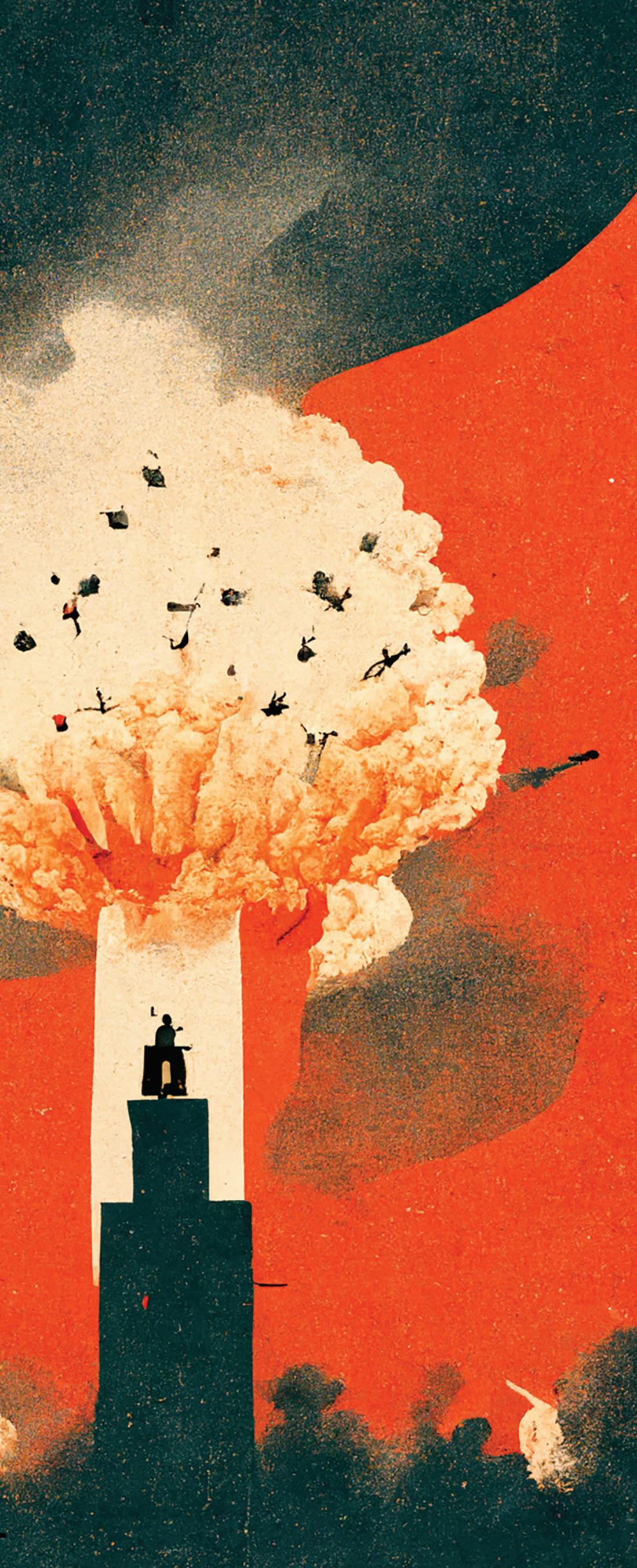
“We see people who have gone through war, people who have gone through torture, and you’re bringing their trauma into your sphere,” Devoe says. “From an evolutionary perspective, we want to have that empathy built in, but then all of a sudden we’re experiencing trauma through someone else’s unfortunate events.”
Staying informed, however, is also a way to cope with uncertainty and threat, and even to be part of the solution. In an address to Canadian post-secondary students in June, Ukrainian President Volodymyr Zelensky urged viewers not to ignore the war, but to help spread the word about the invasion through social media, stressing that this is as important as weapons in combatting the invaders.
“Knowing what’s going on, understanding current events, conceptualizing them in a proper way is part of our social norms and part of being involved in a social culture,” Devoe says.
Striking a balance between being informed and being overwhelmed is important. Limiting exposure is a step towards better mental health. That could include taking news apps off phones and only reading about the war during certain times, such as after dinner or while on a lunch break. Self care is also important, for example, taking part in relaxing and soothing activities like a walk, a bath, exercise and maintaining a work-life balance.
“These are things that we hear all the time, but they’re actually very important when it comes to maintaining our mental health.”
Alumnus Jonathan Stewart (Bachelor of Applied Communications — Journalism, 2010) had been teaching English in hard-hit Kharkiv, Ukraine’s second-largest city, for five years when Russia attacked. Here he recounts his experience amid conflict, how he managed to escape the country and witness both the best and worst of humanity at the same time.

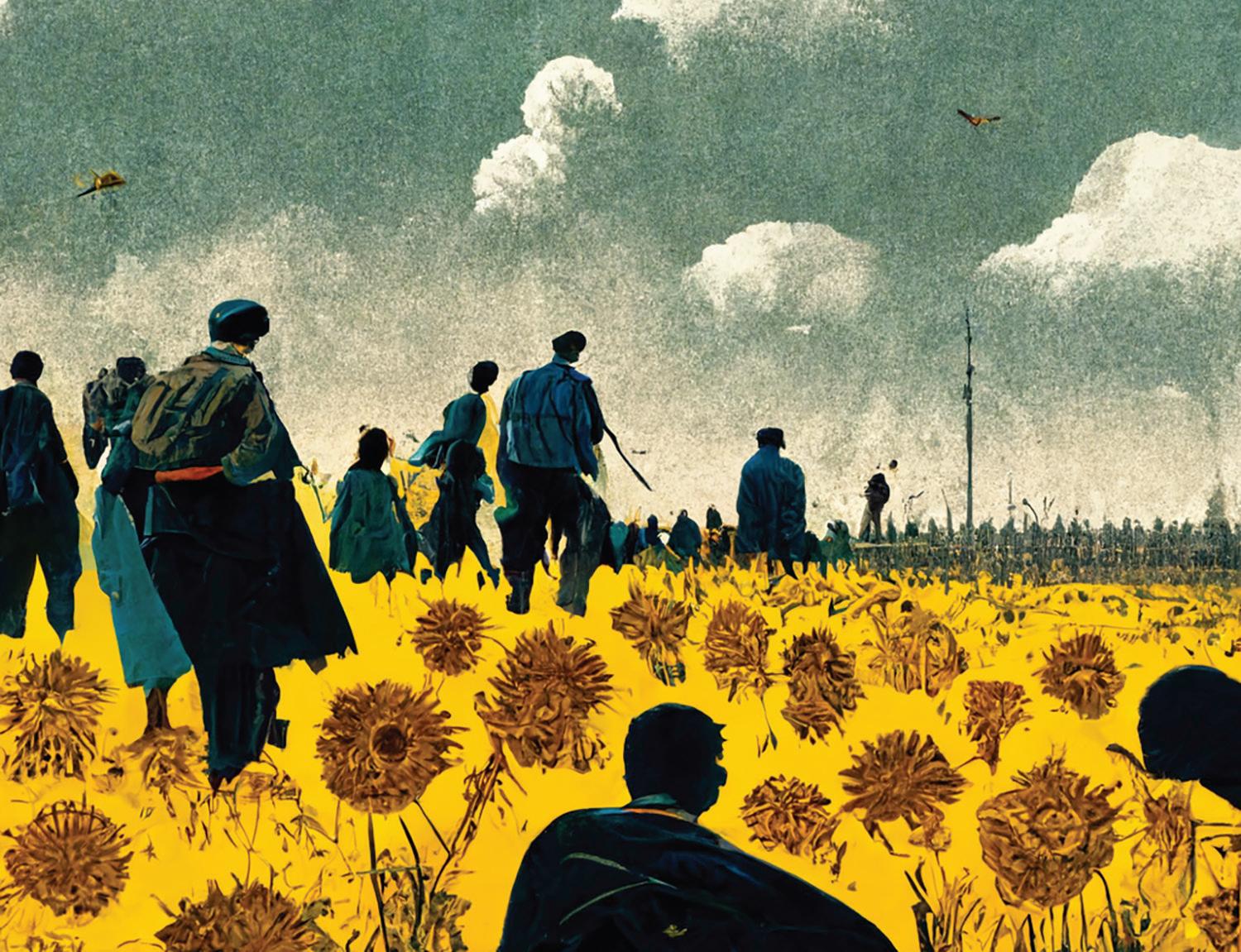 Words by Jonathan D. Stewart
Words by Jonathan D. Stewart
Itstarted at 5 a.m. the day after my birthday, Thursday, Feb. 24. I woke to use the washroom and returned to bed, but before falling asleep I heard the bombs in the distance. I was not surprised, but I was not processing the full significance of the moment. I put in earplugs and went back to sleep, knowing I wouldn’t get called into work that day.
Deciding I would be safe enough at home, I stayed for the whole first week. Luckily, I had a full fridge and freezer, but I was running low on water, which normally would have been delivered. I filled a six-litre plastic bottle at a natural spring, checking to see what things were like in the city. Very few people were outside, only soldiers guarding areas and buildings. I went back a couple days later and the roads and highways were blocked, so I couldn’t get far.
I walked down the main street to see if any shops or kiosks were open and passed a
building full of soldiers. I heard a guy yelling, but didn’t understand what he was saying. Then I heard louder shouting using profanities and understood, but didn’t think it was being directed at me. A shot rang out very close by, and I ran. I asked a friend in the Ukraine army why they had shot at me and he said it was a warning. I wasn’t supposed to be there and the next shot would have been in my back.
Everyone else left my building. Some people went to villages and others went to a nearby bunker. I watched the news and TV and spoke with friends about what they were doing, hiding in the washroom during shelling. Everyone went home to their families.
Friendship means nothing in war. Only family matters.
The worst was when I covered all my windows with blankets and paper and the darkness started to affect me after just a few days. I can’t imagine how people stayed underground for months. I would have gone mad.
At the end of the week I looked out my window while cooking breakfast to see three military trucks driving by. At that moment I thought they were our guys because they had a “V” painted on the side, not a “Z.” I discovered later that they were Russian naval forces, likely captured or killed not long after I saw them.
I realized I needed to get the hell out of Ukraine. I had friends who operated an orphanage in a village south of the city, and I contacted them to ask if I could be escorted there. The next day, a van came to pick me up. I packed some bags, locked my house and left, not knowing when or if I would be back.
The city was being shelled while I walked to the van. Hearing jets fly overhead, shooting missiles and dropping bombs that shake your bones, is an experience I don’t want to repeat. War is hell on earth. It’s the worst experience I have ever had. There is a sinister terror that is hard to explain … understanding that people are being murdered all around you is very strange. In war, everything can kill you. The sky, the trees, the ground. It opened my mind to the reality of the world, to a very dark side of humanity we all have in us.
I stayed a few days at the orphanage and was very comfortable with my own room and bed. I was fed three warm meals a day.
After three days it was arranged for me to be driven to the western border with a family that was trying to get to Germany. Dima and his wife and children had obtained a small old red Russian Lada that broke down an hour into our trip and needed to be towed by another car into our first city for the night. We didn’t get into Poltava until 10 or 11 p.m., which was quite nerve-racking because there was a 3 p.m. curfew and we were told that we could be shot if we were out after that time. The soldiers may have considered us a threat. When we finally made it, we stayed with Dima’s friends in a church basement.
After four days we made it to the Romanian border. Dima was eligible for conscription and they would not let him through. We went to the Moldovan border, but he had the same problem there. I gave him a lot of American dollars to bribe the guard and we tried for a while, but eventually I said I had to cross and I left him and his family behind.
For weeks and months after, I felt guilt that made me feel sick, but I know now it would have been pointless to stay and attempt to fight with my limited ability with the language and lack of experience in combat. I realized I must do what I can from Canada for now until I can return to Ukraine and help with the rebuilding efforts.
I spent two months in Moldova, Romania, the Czech Republic and, finally, Turkey, before I returned to Canada. Sometimes I wonder if I wasn’t killed in Ukraine and now I’m in the afterlife. I can’t understand how two insanely different realities can exist so closely to each other.
I have never seen anything like the courage I saw displayed by soldiers, volunteers, charity workers and ordinary people in Ukraine.
Ukraine, as with all countries in the world, should have the right to choose their own future. Ukraine is not a part of Russia. They have a distinct culture and history. They, as other nations, should have the freedom to determine their own path forward. This is a fight the West should stand behind.
Properly providing a home in emergency circumstances requires extreme effort amongst imperfect systems.
Words by Michelle BodnarUkraine’s bravery in the face of what many thought was an unwinnable war has reaffirmed the idea that democracy is worth fighting for. But combat always comes with a price. According to Statista.com, as of September there were close to 12.7 million border crossings recorded from Ukraine to other countries since February, with Poland now hosting the vast majority of displaced people.
In Canada, Ukrainians are arriving under the auspices of the Canada-Ukraine Authorization for Emergency Travel (CUAET), which is described by Immigration, Refugees and Citizenship Canada as “a special, accelerated temporary residence pathway for Ukrainians seeking safe haven in Canada while the war in their home country continues.” Ukrainians and immediate family members of any nationality are able to stay for up to three years and can apply for an open work permit at the same time as their visa application. The federal government has created a national job bank to link employers to Ukrainians, who can also choose to study if they wish. They may receive a one-time payment of $3,000 per adult and $1,500 per child under 17 years old.
CUAET is technically not a refugee program, explains Dr. Leah Hamilton, PhD, a management professor with MRU’s Bissett School of Business who researches the social and economic integration of newcomers and refugees in Canada. It is a stopgap program where there is no refugee immigration stream.
 a crowd of people, waving canadian flags,
a crowd of people, waving canadian flags,
“CUAET uses an existing temporary resident visa process to bring as many Ukrainians as possible quickly into Canada,” Hamilton says. As of Oct. 7, 600,551 applications had been received and 290,818 approved, according to the Government of Canada.
“Some immigration experts have mused that this might be a new era of refugee policy in Canada,” Hamilton says.
The benefits of CUAET are that it gets people into Canada fast and they can start working right away. But protections are only temporary.
“They don’t have permanent residency and so they don’t get the same sort of settlement supports that other refugees get,” Hamilton says. When CUAET was launched, Ukrainians didn’t even have access to language programs, which has since been rectified.
Many details are also up to the specific provinces. The Alberta government has announced an additional six months of income support for Ukrainians and six months of funding to cover the cost of licenced child care through the Child Care Subsidy Program. The provincial NDP has called for free translation services for important documentation and fees for knowledge and road tests to be waived.
Resettlement supports require all levels of government to work together, and there is still some figuring out to do, Hamilton says.
There is a glaring gap in the CUAET policy, as it does not address non-Ukrainians and undocumented persons fleeing the country.
“This policy or program is really for Ukrainians; but not everyone who lives in Ukraine is Ukrainian,” Hamilton says.
In truth, refugees from other countries, non-Ukrainians and visible minorities are not receiving the same type of welcome as Ukrainians, particularly in Europe. A February 2022 CBC article quotes Bulgarian prime minister Kiril Petkov, who said, “These are not the refugees we are used to; these people are Europeans. These people are intelligent. They
are educated people … This is not the refugee wave we have been used to, people we were not sure about their identity, people with unclear pasts, who could have been even terrorists.”
Those comments have been correctly called out as racist and Islamophobic, and serve to describe the barriers certain refugees face in an extremely ugly manner.
Professor of sociology, Dr. Mark Ayyash, PhD, is a specialist in violence, social and political theory, and the history, culture and politics of the Middle East (particularly Palestine-Israel).
“Of course, there’s racism when it comes to the refugee issue, obviously. It is clear as daylight how the difference in which especially the European nations are welcoming Ukrainian refugees, openly talking about Russian aggression and arming the resistance, versus refugees from Afghanistan and Syria,” Ayyash says. Since 2015, 44,620 Syrian refugees have arrived in Canada, and 17,590 Afghans since August 2021.
Countries are protecting their strategic and geopolitical interests, and, “Unfortunately, there is no moral compass that guides international affairs,” Ayyash says.

It’s possible that even when the RussoUkrainian war is over, many Ukrainians will choose not to return home.
“They become settled, the children are in school, they get jobs, people build their social networks, and so time is actually really important when it comes to that choice,” Hamilton says.
“I think what scholars would argue is the faster this conflict is resolved, the more likely it is that people will want to return home right away.”
Canada needs to be prepared to continue to work together to provide resources and various options for all displaced people. As unrest continues around the world, the job is not yet done.
In 1972, Mount Royal’s main campus building opened and was a multi-purpose marvel of brutalist architecture with a ton of great characteristics.


Lincoln Park was erected in the middle of the site of a former airfield surrounded by military bases and flanked by two major roadways. It was a brand-new, modern “mega-structure,” writes former Mount Royal president (1980 to 1989) Donald Noel Baker in his book Catch the Gleam: Mount Royal, From College to University, 1910 to 2009 Architects worked to deliver a “high-quality academic shopping mall,” Baker says, and they succeeded, establishing a flexible learning space encompassing 60,121 square metres.
Along with “huge open multi-purpose spaces and wide corridors,” the new Lincoln Park
Campus building also housed an art gallery, a billiards hall, a fireside lounge, Dairy Bar, Pancake House, Pizza Place, Soup Kettle Inn, a gymnastics studio, a barber shop and hair salon, and the campus favourite, the Rathskeller pub. Officially opened on Nov. 17, 1972, with such dignitaries present as Howard P. Wright (the namesake for the Wright Theatre on campus), Leonard H. Leacock (Leacock Theatre), George D. Stanley (Stanley Gym), John Stevenson (Stevenson Plaza), Henry M. and Ronald H. Jenkins (Jenkins Theatre) and Dr. John H. Garden (Dr. John H. Garden Memorial Park), Lincoln Park began a new era of educational and cultural life in Calgary. Lieutenant Governor Grant McEwan and Premier Peter Lougheed were also in attendance.
Mount Royal’s original downtown campus was at peak capacity in 1964/1965. With 4,300 students registered, the then-junior college began to look for a way to expand from its old building located at 1128 7 Ave. SW, which was affectionately nicknamed “The Barn.” The College also owned four additional properties on the same block, including one that still stands today. Constructed in 1949 at 1133 7 Ave. SW, the Kerby Memorial Building is the current home of the Kerby Centre for the 55-Plus.

In the 1965 Mount Royal yearbook, the Varshicom (the name recognizes the three fields of learning at the college, namely, university [varsity], high school and commercial) included an article titled “MRC campaigns for a new campus” explaining, “Due to the high cost of down town development, a suburban site would have been more suitable and when Lincoln Park was purchased by the city from the Federal government the college began to think of the possibility of establishing itself there. However, there were other contenders for the property. The Calgary Exhibition and Stampede Board also wants the site and began an expensive publicity campaign for the property. The students of MRC, feeling the cramped campus growing more crowded each month, decided on a course of action that took them to city hall with pickets declaring their case.”
This show of solidarity caused Calgary’s City Council to agree to sell 146 acres of the former Royal Canadian Air Force base to the provincial government for a combined tech-junior college campus for a total price of $373,030. The completed complex cost $15,101,010.
Joel Barrett, an architect from the firm Stevenson, Raines, Barrett, Hutton, Seton and Partners, which designed the original Lincoln Park building, noted his vision in a paper preserved in the Mount Royal University Archives and Special Collections located in the Riddell Library and Learning Centre. Barrett highlighted four areas: 1) the building form; 2) the building system; 3) interior environment; and 4) Mount Royal College — the programs.
In an excerpt, Barrett writes, “The building form is linear in concept but is developed around a stepped plaza court open on one side to the South sun, small pond and playfields, turning its back to the harsh North-West winds.
“The original technique used to relate these facilities was a linear mall, much like that of most North American shopping malls. Along this three-story mall were placed stairways, elevators and washrooms required to service the College. To the outer side of the mall are the flexible formal learning spaces. To the inner side of the mall are the more fixed informal learning and amenity spaces, the shopping, dining, lounge and recreational areas.”


The Archives and Special Collections holds a variety of records documenting the planning and construction of the Lincoln Park Campus, including photos, reports, campus newspapers and architectural drawings.
“Historical records like these are preserved by archives so that they can be used by current and future generations of students and researchers to learn about the past and to understand how today’s communities and their surroundings developed over time,” says Peter Houston, associate professor and archivist/librarian at Mount Royal.
At College Mall Hair Styling — located between the Pancake House and the Soup Kettle Inn — a complete hairstyling cost $5 and cuts cost $3 and up, depending on length. A tapering was just $2.75.

Mount Royal College had to beat out several propositions for its land, including:
• The Calgary Exhibition and Stampede (Petition contained about 2,500 signatures)
• Industrial purposes or for an airport (Petitions contained 1,233 signatures of surrounding residents)
The Rathskeller was MRC’s first on-campus bar, located where Tim Hortons is now. It was decorated in German beer-hall style and often featured live music and performances.


As a community college with an “open-door” policy (the only requirement was that students must be 18 years old), the one- or two-year programs on offer at Lincoln Park were primarily in career-oriented fields such as secretarial, business administration, community service training, library clerical training, interior design, architecture, day care, industrial security, police science, stenography, journalism, and radio and television training. MRC was affiliated with the University of Alberta, where students could transfer after two years at the college.


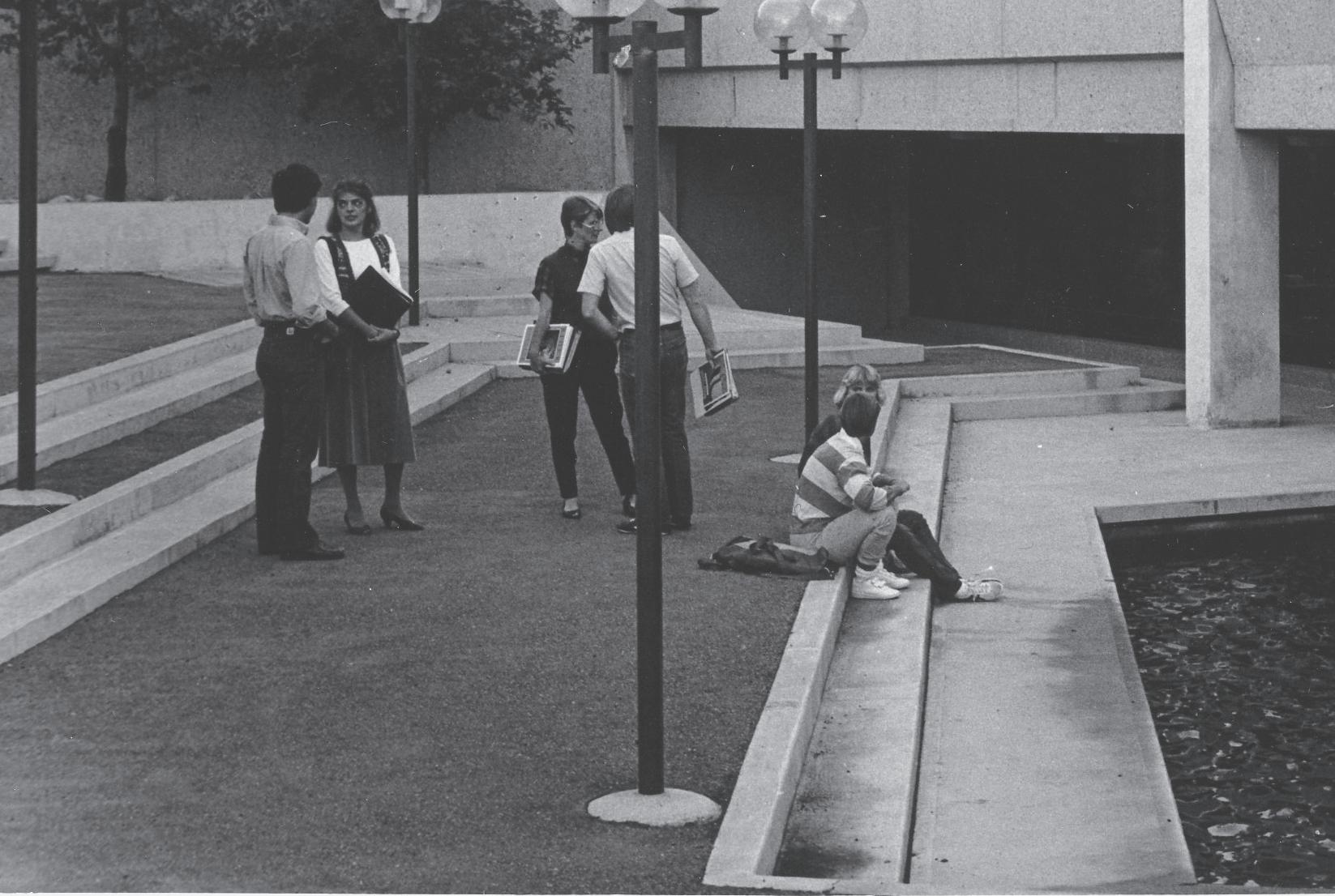
“The educational program for Mount Royal College attempts to provide an educational model and building form that can provide individualized programs, self-paced instruction, using problem-solving techniques, hand and computer monitored testing, adequate counselling, informal learning, in an interdisciplinary community of learners, community and related programs, and a home-base and recreation centre,” architect Barrett wrote.
With the new building, the Conservatory was able to expand its audience on the new campus through the construction of the 297seat Leacock Theatre, and three other theatres (Ford, Jenkins and Wright) offered additional performance and lecture space.
“Every inch of the building suggests new ways of learning things … Physically, the move is a century jump,” wrote the Calgary Herald in 1972.
Janet Brown, MRC photographerFor an online look at MRU “Then and Now,” go to mru.ca/Lincoln50. Follow the MRU social accounts to let us know of your favourite campus memory, and to contribute to the continued growth of the University, take part in Giving Day on Nov. 29 at mru.ca/GivingDay



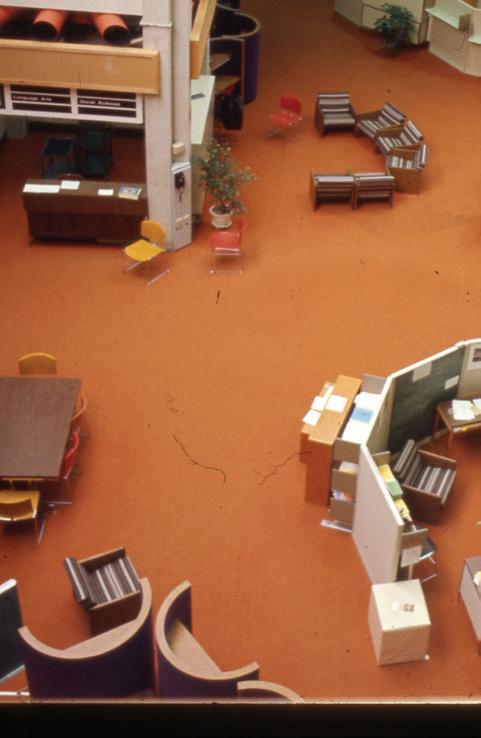



Giving Day is 24 hours of coming together to support MRU students. Join in on several fun challenges throughout the day on Nov. 29 and reconnect with your MRU community.
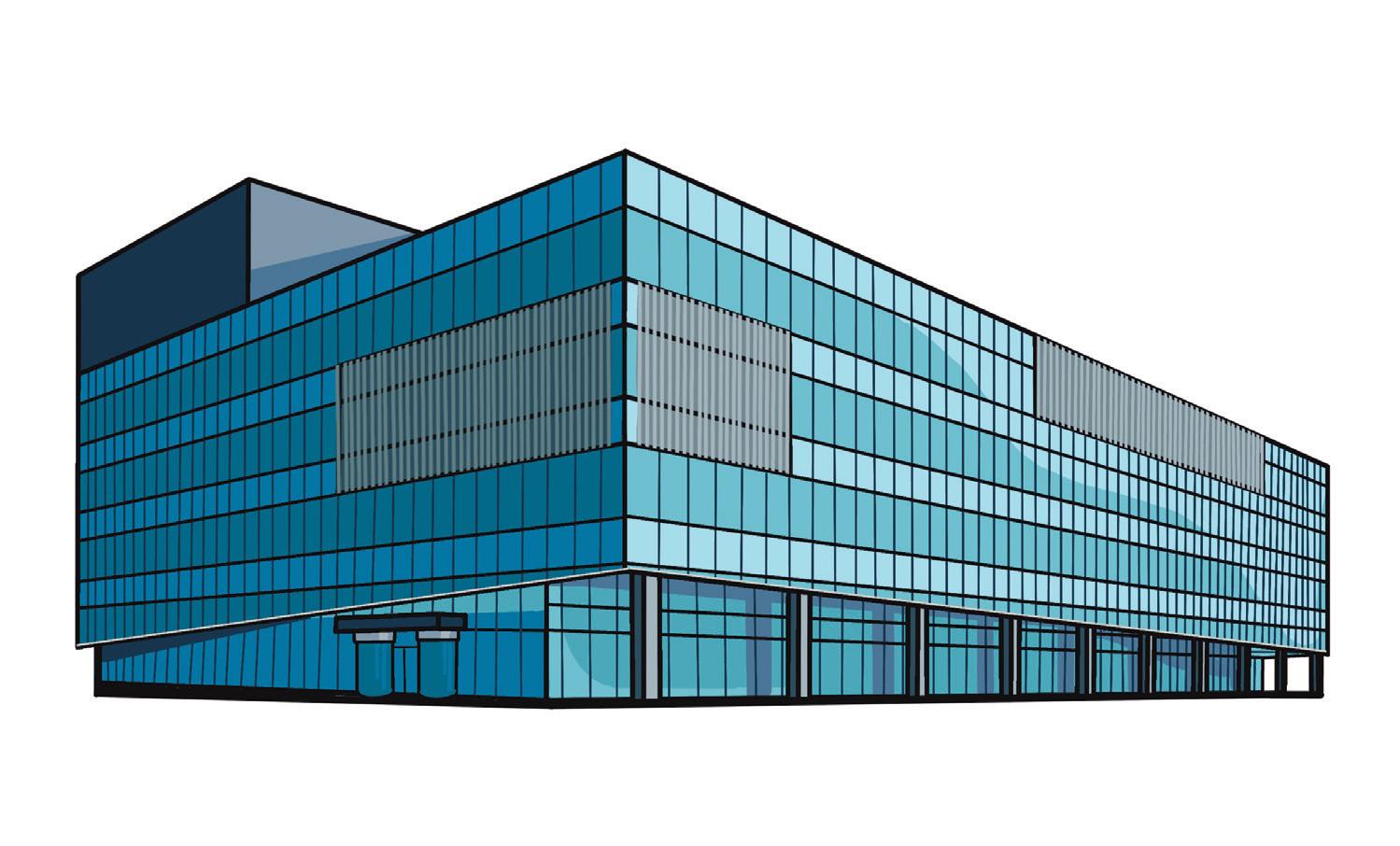
This world-class performing arts facility is the result of the singlelargest gift to MRU, bestowed in 2010 by Don and Ruth Taylor and the Taylor Family Foundation, and is home to the world-renowned Conservatory and the acoustically perfect Bella Concert Hall.






Located in the Taylor Centre for the Performing Arts, the TransAlta Pavilion commemorates TransAlta’s contribution to the Conservatory campus expansion plan and is a space for events, rehearsals and performances.
Support from sporting community icon Joan C. Snyder created the Joan C. Snyder Early Childhood Suite in the Conservatory, which provides programs teaching music, speech arts and drama to children and youth.
Situated adjacent to the tranquil Charlton Pond, the TransCanada Amphitheatre is the home stage for a number of outdoor performances held throughout the year (and even the occasional wedding), and serves as a community gathering place.
The growth of the Mount Royal campus over the past 50 years
Named in honour of the generous contributions of geologist, oil executive and philanthropist Clay Riddell and family, the Riddell Library and Learning Centre opened in 2017, home to the MRU Library, the Academic Development Centre, the Archives and Special Collections and several experiential learning spaces.

With support from the Taylor Family Foundation, the newest transformation on campus is currently underway as the old Library and Conservatory spaces are repurposed into new classrooms, study spaces and a flexible hub and gathering space.
Extension and named in honour of distinguished alumnus Roderick Mah, the RMCCL building recognizes generous gifts by Mah’s friends Norman Wong, Donald McCaffrey and Wayne Chiu.
Found within the RMCCL and part of a campus expansion completed in 2006, Ross Glen Hall seats 600 people and commemorates the outstanding contributions to MRU by Glen, his family and RGO Products.
This peaceful space is named for Rev. Dr. John H. Garden, the first student to enrol at Mount Royal in 1911, and was made possible in 1998 by a six-person volunteer committee. It is dedicated to those who have memorial endowments named in their honour.
Housing a handmade pipe organ gifted by the Carthy Foundation, the Wyatt Recital Hall not only recognizes that amazing gift but the dedication of Hal and Marnie Wyatt to MRU in the form of the Wyatt Artist-in-Residence Program and Concert Series and the newer Hal and Marnie Wyatt Atelier.

Situated near the site of the former British Commonwealth Air Training Plan’s No. 3 Service Flying Training School, the Bissett School of Business
2006 announcement that Calgary philanthropist David Bissett had contributed the largest gift ever to a


Opened in 2019, this innovative stateof-the-art lab lets students seek out and analyze live and historical business data crucial to understanding how ethics, the environment and other factors combine to influence decision-making and the
This contemporary co-working space for social innovators from across sectors and for student changemakers from all faculties and disciplines was made possible by Wayne and Eleanor Chiu, founders of the Trico Charitable Foundation.

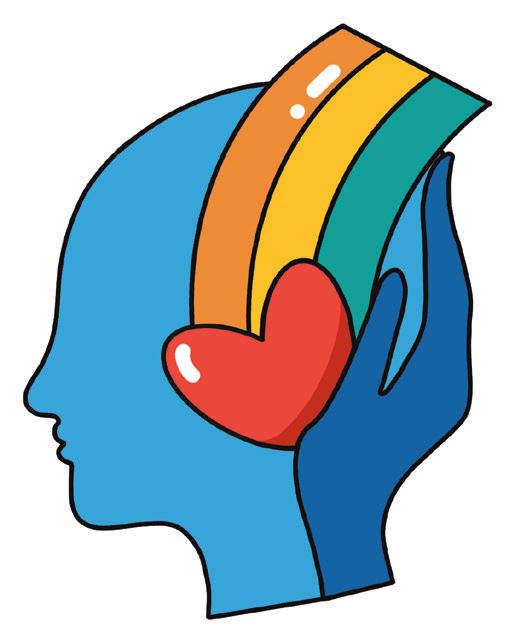
In 2003 the Encana Wellness Centre brought all MRU health programs together into one unit, making them more easily accessible to the campus and external communities.
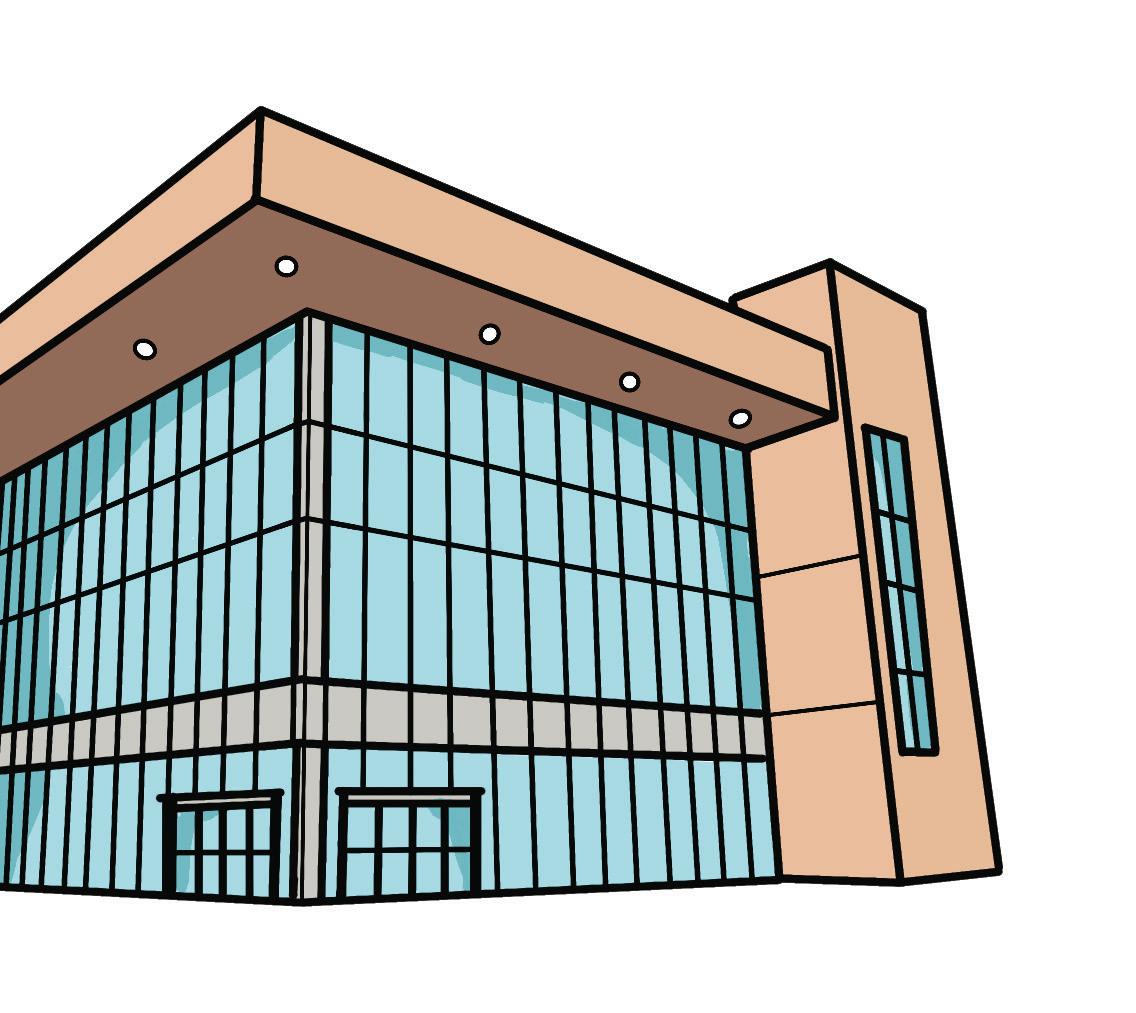
In 1992, the Nickle Family Foundation made the Nickle Theatre possible — a cutting-edge space providing students with hands-on training preparing them for the professional world.
To see how you can make an impact at Mount Royal University for its students and the future, visit the MRU Foundation website at foundation.mru.ca
general studies courses. For his work towards total social inclusion, earlier this year Crump was named as a “Calgarian we love’’ by Avenue magazine and as a “Compelling Calgarian” by the Calgary Herald

I’m a social entrepreneur using my voice, lived experience and passion for building a barrier-free community to make a difference.
The year 2004 was pivotal in my life. Before that, accessibility and universal design weren’t things I gave much thought to. I had never experienced an injury or disability and didn’t know anyone living with one at the time. That is, until my accident that summer.
I was camping with a group of friends and decided to “take a dip,” running and diving into the lake. I hit a sandbank, breaking my neck. In recovery, I started noticing how challenging it was to co-ordinate things as simple as getting together with my friends, going over to someone’s house, finding a place to grab a drink or even finding a place to live.
I was no longer able to participate and navigate as freely as I once did.
With this inequity becoming very apparent, I started familiarizing myself with global universal design principles and practices. As I better understood how accessibility and barrier-free spaces can be conceptualized and implemented, I wanted to start promoting these practices and cultivate
truly inclusive environments to create equal opportunity for everybody.
Universal design is designing something, a product, service, space or experience, that can be enjoyed or utilized by everyone. With universal design, we can build a society that ensures opportunity, involvement and an equally obtainable quality of life.
I turned my new way of living into fuel for social change and started Universal Access, a consulting business focused on building beyond the minimum. When the Trico Changemakers Studio opened its doors at MRU, Universal Access was quickly drawn in and we became early tenants. The Studio, with its like-minded thought leaders and entrepreneurs, helped catapult our business into the social sector and created incredible connections as we were scaling our early concept into a newly emerging market.
Stemming from Universal Access came Included by Design, incorporated early in 2021. This transition materialized from an opportunity to merge with another social enterprise and start moving to a technology and product-led offering, allowing us to maximize our impact. Included by Design’s Accessible Design Plan helps improve accessibility and encourages businesses to become certified so they can better accommodate the disability community (representing 22 per cent of our population). Once certified, businesses are onboarded to our new digital platform Krooshl. com, which allows users to register for events and provide information about their needs before their arrival. We help create immersive communities and spaces where all people feel comfortable participating.
Passionate and purposeful about my work, I am excited to share my knowledge of the relationship between spatial layout, social inclusion and economic participation. The future can be inclusively conscious, and I’m optimistic things are moving in the right direction.
Words by Sean Crump

